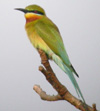* The fully revised 2015 edition is not yet available from Amazon but we managed to buy a copy in Melbourne.
Several of the birding field guides are now available as Apps, with the added advantage of bird calls included on your smart phone. Visit either Google Play or Apple App Stores and check out Pizzey & Knight Birds of Australia Digital Edition or The Michael Morcombe eGuide to Australian Birds.
 GUIDES
GUIDES
- Melbourne Steve Davidson – contact by email or +61 431 530 631
- Kiama Bob Ashford - contact by email or +61 244 641 574 or +61 404 863 187
- Sydney Centennial Park Alan Richards - contact by email
See Diary for details of our birding experiences - we were put in touch with Alan Richards by Bob Ashford.
ITINERARY & DIARY
AUSTRALIA
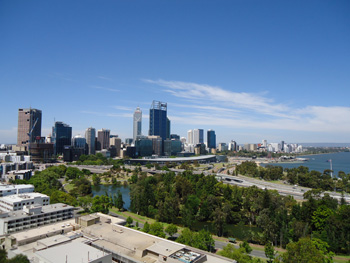 8th December 2015 – Fly to Perth – Western Australia with Emirates via Dubai
8th December 2015 – Fly to Perth – Western Australia with Emirates via Dubai
9th December – Arrive in Perth at 6.30pm getting to Mantra on Hay Street by 8pm
Car – Mitsubishi XB2L45 SUV. The couple in front of us at the car hire desk took a lifetime to get sorted and it was dark before we left the airport. Perhaps we should have taken the optional Satnav? Luckily we chose the right direction and only had to ask our way once. A few laps of the hotel area (just for fun!) and we were there.
10th December – Victoria Dam & Lake Monger
Despite a late dinner and sorting ourselves out the previous night, we were up at 06.00 had spotted our first Red Wattlebird, one of the most common and conspicuous species, especially around flowering Banksia, Australian Ringneck and Rainbow Lorikeet and were on our way after a quick breakfast to Victoria Dam, which was easy enough to find. The open water held little of interest, but paths and the picnic area below the dam were much more productive. 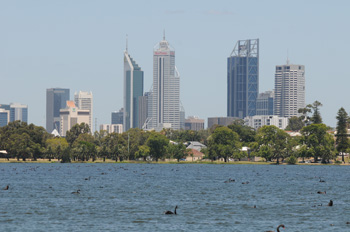 Highlights included 2 White-cheeked Honeyeater, Splendid, Blue-breasted and Red-winged Fairywren, Western Whistler and 2 White-breasted Robin. Around noon we got back on the road and headed to the north of the city to Lake Monger. Having only met a couple of people at the dam, this urban site was well used by locals and birds alike. A good range of waterbirds included Musk Duck, Blue-billed & Pink-eared Duck, together with a rare sight here, a Mute Swan amongst hundreds of Black Swans. As we walked around the perimeter of the lake we spotted a pair of amorous Black-faced Cuckooshrike chasing around the treetops, a single Brown Falcon and Striated Pardalote amongst others. A flock of c50 Little Corella foraged on the grassland around the lake with c6 Long-billed Corella nearby, together with a pair of Western Rosella.
Highlights included 2 White-cheeked Honeyeater, Splendid, Blue-breasted and Red-winged Fairywren, Western Whistler and 2 White-breasted Robin. Around noon we got back on the road and headed to the north of the city to Lake Monger. Having only met a couple of people at the dam, this urban site was well used by locals and birds alike. A good range of waterbirds included Musk Duck, Blue-billed & Pink-eared Duck, together with a rare sight here, a Mute Swan amongst hundreds of Black Swans. As we walked around the perimeter of the lake we spotted a pair of amorous Black-faced Cuckooshrike chasing around the treetops, a single Brown Falcon and Striated Pardalote amongst others. A flock of c50 Little Corella foraged on the grassland around the lake with c6 Long-billed Corella nearby, together with a pair of Western Rosella.
11th December – Wugong Dam, Penguin Island, Rockingham & Thomson Lake (dry)
Another early start saw us taking a very circuitous route to Wugong Dam. We were almost at Rockingham before we realised the directions we had assiduously copied from Google Maps were a little misleading and certainly very difficult to follow: we had missed both the turnings to Thomson Lake and Wugong Dam. It was a beautiful day: cloudless sky and temperatures heading for 28° - what a pity there were hardly any birds around, apart from Rufous Whistler, singing it’s head off from deep cover, 2 secretive Australian Ringneck and a couple of Splendid Fairywren. 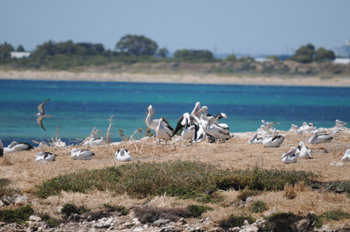 Could the day get better? The roads and tracks were inundated with annoying flies; there were signs at most junctions forbidding entry, almost on pain of death it seemed; there was only one other car in the car parks and apparently no one else around. All of a sudden we spotted birds flitting about in the bushes along the road, so, being all alone we sought shelter under a roadside tree and tried to remain inconspicuous in the vehicle so as not to disturb the birds. We had been stationery for a little over a minute, when along came a park ranger in his big “ute”; he drove slowly by and then stopped about 30 metres away. Little did we know we were about to meet the biggest “jobsworth” in the whole of Western Australia. His thought processes must have been a little slow, possibly the heat, but probably not, as after another minute or two’s thought, he slowly reversed until he came alongside us. No such niceties as “G’day Bruce” he went straight in to his script and told us in no uncertain terms we were blocking his hitherto unused road and we needed to move 50 metres into the nearby empty car park, thereby freeing the “highway” – officious prick! Anyway, welcome to Western Australia.... didn’t have a lasting effect on me at all!!! While we parked up, the birds stopped calling and moved on: we managed 8 species in total for the site. We also saw several small flocks of Straw-necked Ibis a few kilometres from the dam.
Could the day get better? The roads and tracks were inundated with annoying flies; there were signs at most junctions forbidding entry, almost on pain of death it seemed; there was only one other car in the car parks and apparently no one else around. All of a sudden we spotted birds flitting about in the bushes along the road, so, being all alone we sought shelter under a roadside tree and tried to remain inconspicuous in the vehicle so as not to disturb the birds. We had been stationery for a little over a minute, when along came a park ranger in his big “ute”; he drove slowly by and then stopped about 30 metres away. Little did we know we were about to meet the biggest “jobsworth” in the whole of Western Australia. His thought processes must have been a little slow, possibly the heat, but probably not, as after another minute or two’s thought, he slowly reversed until he came alongside us. No such niceties as “G’day Bruce” he went straight in to his script and told us in no uncertain terms we were blocking his hitherto unused road and we needed to move 50 metres into the nearby empty car park, thereby freeing the “highway” – officious prick! Anyway, welcome to Western Australia.... didn’t have a lasting effect on me at all!!! While we parked up, the birds stopped calling and moved on: we managed 8 species in total for the site. We also saw several small flocks of Straw-necked Ibis a few kilometres from the dam.
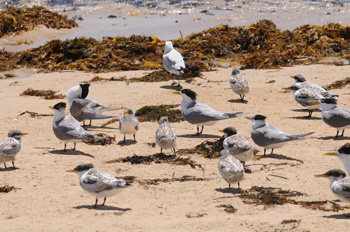 Time to retrace our steps and go to Rockingham where we arrived c12.45. With a few Australian Pelican flying overhead and a Nankeen Kestrel and several Singing Honeyeater around the car park, we joined the queue for the ferry across to Penguin Island. The crossing takes about 5 minutes and is quite shallow with a convenient sandbar stretching from the mainland just below the surface and several groups were saving the ferry fare and wading across. As we neared the island we saw the first of c1000 Bridled Tern, our main target here, along with a similar number of Greater Crested Tern. The breeding colonies here are so close to the paths, you are almost tripping over the birds as they go about their business. During the day the breeding Little Penguin colony is empty as the birds feed out at sea: if you want to see a penguin on one of these trips, you either need to be extremely lucky and spot one under the boardwalk or visit the Discovery Centre on the island where a few injured birds are usually recovering. We did see one baby bird, just out of the egg and no bigger than a golf ball, being held and cared for by one of the wardens.
Time to retrace our steps and go to Rockingham where we arrived c12.45. With a few Australian Pelican flying overhead and a Nankeen Kestrel and several Singing Honeyeater around the car park, we joined the queue for the ferry across to Penguin Island. The crossing takes about 5 minutes and is quite shallow with a convenient sandbar stretching from the mainland just below the surface and several groups were saving the ferry fare and wading across. As we neared the island we saw the first of c1000 Bridled Tern, our main target here, along with a similar number of Greater Crested Tern. The breeding colonies here are so close to the paths, you are almost tripping over the birds as they go about their business. During the day the breeding Little Penguin colony is empty as the birds feed out at sea: if you want to see a penguin on one of these trips, you either need to be extremely lucky and spot one under the boardwalk or visit the Discovery Centre on the island where a few injured birds are usually recovering. We did see one baby bird, just out of the egg and no bigger than a golf ball, being held and cared for by one of the wardens. 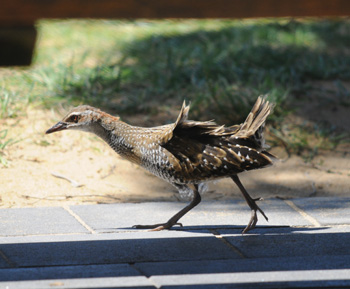 After walking around the island we returned to the visitor centre and while we sat at a picnic bench enjoying a drink of cold water and adjoining benches were vacated by fellow visitors, a Buff-banded Rail ferreted around under the benches. As we returned to the dock to get the ferry back to the mainland, we were watching the terns on the adjacent sandbar when a Fairy Tern floated by and landed just a few metres away. Unfortunately, people were still wading across from the mainland and their approach disturbed the terns and although most returned, they were only Bridled & Greater Crested.
After walking around the island we returned to the visitor centre and while we sat at a picnic bench enjoying a drink of cold water and adjoining benches were vacated by fellow visitors, a Buff-banded Rail ferreted around under the benches. As we returned to the dock to get the ferry back to the mainland, we were watching the terns on the adjacent sandbar when a Fairy Tern floated by and landed just a few metres away. Unfortunately, people were still wading across from the mainland and their approach disturbed the terns and although most returned, they were only Bridled & Greater Crested.
Returning to Perth we eventually found Thomson Lake c16.00 which had already dried out this year. We only saw a handful of birds including Whistling Kite, 2 Sacred Kingfisher and 2 Pied Butcherbird. Three Western Grey Kangaroo loitered on the dry lakebed in the distant heat haze. On the way back to the city we also managed to spot a single Black-shouldered Kite and Swamp Harrier.
12th December – Drive to Cheynes Beach c9.00am via Canning Dam & Albany, arriving c4.00pm
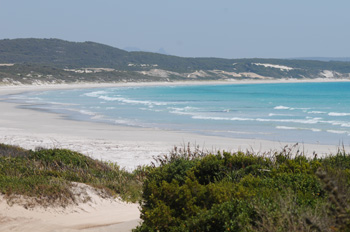 Total journey is about 500km. Heading south on Highway 30 from Armadale, about an hour into our trip, we decided to detour to Canning Dam having seen records of some good sightings in a number of trip reports. Temperature was in the mid 20°c by then and birds were either skulking or had just gone away. Not really worth the effort for 7 common species. We stopped at Albany for some provisions for the next few days as only basic supplies are available in the shop at Cheynes Beach Caravan Park. Travelling along the South Coast Highway (H/w 1) from Albany we spotted our first Common Bronzewing at the side of the road picking up grit. A few common species were on roadside ponds and a pair of Western Rosella flew overhead. Turning on to Cheyne Road we stopped several times when we saw birds in the roadside scrub: New Holland Honeyeater were the most common species but we did manage to pick out a pair of Tawny-crowned Honeyeater. Black-faced Cuckooshrike were also about along with a rather bedraggled looking Wedge-tailed Eagle. Cheynes Beach is situated in Waychinicup National Park and is also the location of Arpenteur Nature Reserve (a small reserve adjacent to Waychinicup NP). When we arrived there was still plenty of activity around the campsite with Grey Fantail, Silvereye (Grey-breasted), White-breasted Robin, Brush Bronzewing, Western Spinebill and White-browed Scrubwren (Spotted ssp maculatus) all showing well.
Total journey is about 500km. Heading south on Highway 30 from Armadale, about an hour into our trip, we decided to detour to Canning Dam having seen records of some good sightings in a number of trip reports. Temperature was in the mid 20°c by then and birds were either skulking or had just gone away. Not really worth the effort for 7 common species. We stopped at Albany for some provisions for the next few days as only basic supplies are available in the shop at Cheynes Beach Caravan Park. Travelling along the South Coast Highway (H/w 1) from Albany we spotted our first Common Bronzewing at the side of the road picking up grit. A few common species were on roadside ponds and a pair of Western Rosella flew overhead. Turning on to Cheyne Road we stopped several times when we saw birds in the roadside scrub: New Holland Honeyeater were the most common species but we did manage to pick out a pair of Tawny-crowned Honeyeater. Black-faced Cuckooshrike were also about along with a rather bedraggled looking Wedge-tailed Eagle. Cheynes Beach is situated in Waychinicup National Park and is also the location of Arpenteur Nature Reserve (a small reserve adjacent to Waychinicup NP). When we arrived there was still plenty of activity around the campsite with Grey Fantail, Silvereye (Grey-breasted), White-breasted Robin, Brush Bronzewing, Western Spinebill and White-browed Scrubwren (Spotted ssp maculatus) all showing well. 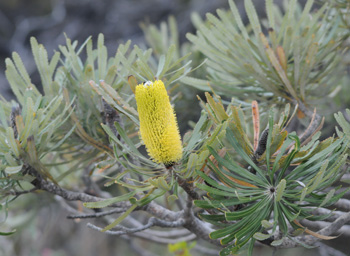 Alongside the usual gulls, Greater Crested Tern patrolled the beach together with a solitary Sooty Oystercatcher. Western Grey Kangaroo roamed freely around the campsite as we settled in and prepared some much needed food and enjoyed a glass of wine after a long hot (c35°C in the hills but a much more pleasant 25° on the coast) drive south.
Alongside the usual gulls, Greater Crested Tern patrolled the beach together with a solitary Sooty Oystercatcher. Western Grey Kangaroo roamed freely around the campsite as we settled in and prepared some much needed food and enjoyed a glass of wine after a long hot (c35°C in the hills but a much more pleasant 25° on the coast) drive south.
Over the next few days we were able to identify some of the dominant flora in the reserve including Baxter's Banksia Banksia baxteri, Candlestick Banksia Banksia attenuata, plus several paperbarks/myrtles including Melaleuca striata and Melaleuca thymoides and Two-leaved Hakea Hakea trifurcata. There were also thickets of Sword-sedges Anarthria spp. and stunted eucalypts and Grass Trees Xanthorrhoea spp.
13th December – Cheynes Beach, Waychinicup National Park, Betty’s Beach
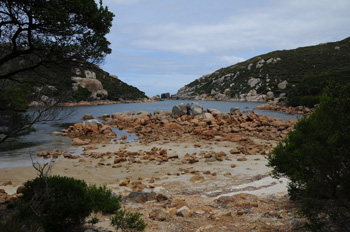 05:30 start today around the perimeter of the campsite at Cheynes Beach and along adjacent tracks which were mainly fine, soft sand and difficult underfoot; very tiring trudging through the heath trying to find the three main skulkers, most of which were very quiet as we were a little late in the breeding season. In 2½ hours we heard 2 Noisy Scrubbird and a single Western Whipbird; not a great return! We did however have close views of a pair of delightful Southern Emu-wren, whilst Splendid Fairywren were reasonably common and 10 Carnaby’s Black Cockatoo were seen on a nearby hillside. White-cheeked Honeyeater was also new for the trip and we enjoyed much better views of Tawny-crowned Honeyeater today. A King’s Skink and several Western Grey Kangaroo were around the cabin when we returned for breakfast. Feeling refreshed we went to the nearby Waychinicup NP where at the beach we saw our first Eastern Osprey: lovely scenery but not much bird life. Heading back towards Albany on Highway 1 we stopped to look at several ponds near Pfeiffer Road and spotted an Australian Grebe together with a White-necked Heron alongside several of the much more common White-faced Heron. We turned off Highway 1 at Manypeaks towards Betty’s Beach which lies just west of Mount Manypeaks NR. More beautiful scenery, but still not many birds about, we did however find a small flock of c8 Yellow-rumped Thornbill plus an adult Red-capped Parrot with a juvenile.
05:30 start today around the perimeter of the campsite at Cheynes Beach and along adjacent tracks which were mainly fine, soft sand and difficult underfoot; very tiring trudging through the heath trying to find the three main skulkers, most of which were very quiet as we were a little late in the breeding season. In 2½ hours we heard 2 Noisy Scrubbird and a single Western Whipbird; not a great return! We did however have close views of a pair of delightful Southern Emu-wren, whilst Splendid Fairywren were reasonably common and 10 Carnaby’s Black Cockatoo were seen on a nearby hillside. White-cheeked Honeyeater was also new for the trip and we enjoyed much better views of Tawny-crowned Honeyeater today. A King’s Skink and several Western Grey Kangaroo were around the cabin when we returned for breakfast. Feeling refreshed we went to the nearby Waychinicup NP where at the beach we saw our first Eastern Osprey: lovely scenery but not much bird life. Heading back towards Albany on Highway 1 we stopped to look at several ponds near Pfeiffer Road and spotted an Australian Grebe together with a White-necked Heron alongside several of the much more common White-faced Heron. We turned off Highway 1 at Manypeaks towards Betty’s Beach which lies just west of Mount Manypeaks NR. More beautiful scenery, but still not many birds about, we did however find a small flock of c8 Yellow-rumped Thornbill plus an adult Red-capped Parrot with a juvenile. 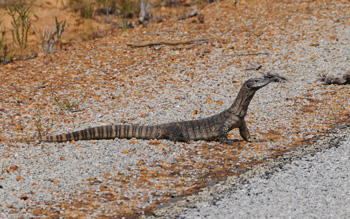 As we returned to Cheynes Beach mid afternoon, along Cheyne Road, we came across a Heath Monitor sunning itself at the side of the road. Luckily no other vehicles were on the road so we were able to watch the ‘Goanna’ for a short while before it got fed-up with our presence and ambled off across the road in front of us. Back at the chalet one of the first birds we saw was a Pallid Cuckoo on the telephone wires just above our parked car and as we did some chores, as well as all the usual species for the campsite we spotted a stunning Gilbert’s Honeyeater near the shower block. Carnaby’s Black Cockatoo feed and roost in the pines in the centre of the campsite, so at c19.00 we wandered along to try our luck. It was a little too early and still light, so we walked to the edge of the campsite where we spotted 3 or 4 birds flying in to the nearby scrub. Edging slowly closer we saw the cockatoos feeding on the Banksia in the distance. Apparently the birds only come to the roost at dusk, which was around 19.40 tonight.
As we returned to Cheynes Beach mid afternoon, along Cheyne Road, we came across a Heath Monitor sunning itself at the side of the road. Luckily no other vehicles were on the road so we were able to watch the ‘Goanna’ for a short while before it got fed-up with our presence and ambled off across the road in front of us. Back at the chalet one of the first birds we saw was a Pallid Cuckoo on the telephone wires just above our parked car and as we did some chores, as well as all the usual species for the campsite we spotted a stunning Gilbert’s Honeyeater near the shower block. Carnaby’s Black Cockatoo feed and roost in the pines in the centre of the campsite, so at c19.00 we wandered along to try our luck. It was a little too early and still light, so we walked to the edge of the campsite where we spotted 3 or 4 birds flying in to the nearby scrub. Edging slowly closer we saw the cockatoos feeding on the Banksia in the distance. Apparently the birds only come to the roost at dusk, which was around 19.40 tonight.
14th December – Cheynes Beach, Porongurup National Park
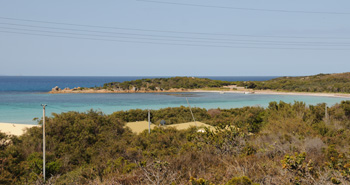 We were out again at 05:30. searching for the skulkers: initially not much happened and it was quiet everywhere with only a lone Brown Falcon to cause any excitement. Rather than walk the same trails this morning we started off walking the inland perimeter of the Cheynes Beach campsite and as we approached the tracks after about an hour we finally heard a Western Bristlebird deep in the Banksia. We walked inland a short way along the second sandy track and heard another Bristlebird and after a patient wait it finally showed itself on top of one of the bushes and we were able to watch it for 5 minutes as it flitted about feeding. We were out for a little over 2 hours with only 10 species to show for it, but these included western Spinebill, Western Whistler, Brown Honeyeater and the seemingly ever-present White-breasted Robin. After breakfast we set out for Porongurup National Park. Driving along Cheyne Road, about half way, c5 km from the South Coast Hwy near the Blue Gum plantations we saw 5 Wattlebirds flying from the treetops. Screeching to a halt, on closer examination they proved to be Western Wattlebird.
We were out again at 05:30. searching for the skulkers: initially not much happened and it was quiet everywhere with only a lone Brown Falcon to cause any excitement. Rather than walk the same trails this morning we started off walking the inland perimeter of the Cheynes Beach campsite and as we approached the tracks after about an hour we finally heard a Western Bristlebird deep in the Banksia. We walked inland a short way along the second sandy track and heard another Bristlebird and after a patient wait it finally showed itself on top of one of the bushes and we were able to watch it for 5 minutes as it flitted about feeding. We were out for a little over 2 hours with only 10 species to show for it, but these included western Spinebill, Western Whistler, Brown Honeyeater and the seemingly ever-present White-breasted Robin. After breakfast we set out for Porongurup National Park. Driving along Cheyne Road, about half way, c5 km from the South Coast Hwy near the Blue Gum plantations we saw 5 Wattlebirds flying from the treetops. Screeching to a halt, on closer examination they proved to be Western Wattlebird. 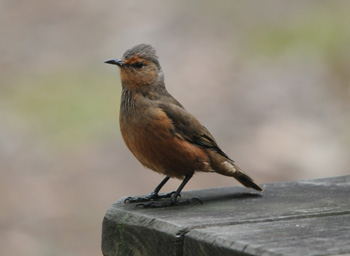 Rather than taking the Highway back to Albany and then heading north, we took Fish Track Road, just west of Manypeaks, and went north on the country roads and tracks (Palmdale Road, briefly, then Mindijup Road across the Kalgan River until we intersected with Takenup Road, and finally, briefly via Armstrong E Road until the intersection with Chester Pass Road, just south of Porongurup NP. This route proved much more interesting than the main highways and in addition to some great scenery, we saw our only Mulga Parrot of the trip, along with several other parrots and more common species. As we approached Porongurup on the Mount Barker Porungurup Road a Square-tailed Kite drifted overhead. We followed the Bolganup Road to the Tree-in-the-Rock Day Use area and in the car park we came across 3 of the most confiding Rufous Treecreeper, foraging on the ground around the picnic tables – more like Robins than Treecreepers! We stayed for about an hour, strolling around the car park and the entrance road and picked up Gilbert’s Honeyeater, Western Yellow Robin, Blue-breasted Fairywren and Spotted Pardalote.
Rather than taking the Highway back to Albany and then heading north, we took Fish Track Road, just west of Manypeaks, and went north on the country roads and tracks (Palmdale Road, briefly, then Mindijup Road across the Kalgan River until we intersected with Takenup Road, and finally, briefly via Armstrong E Road until the intersection with Chester Pass Road, just south of Porongurup NP. This route proved much more interesting than the main highways and in addition to some great scenery, we saw our only Mulga Parrot of the trip, along with several other parrots and more common species. As we approached Porongurup on the Mount Barker Porungurup Road a Square-tailed Kite drifted overhead. We followed the Bolganup Road to the Tree-in-the-Rock Day Use area and in the car park we came across 3 of the most confiding Rufous Treecreeper, foraging on the ground around the picnic tables – more like Robins than Treecreepers! We stayed for about an hour, strolling around the car park and the entrance road and picked up Gilbert’s Honeyeater, Western Yellow Robin, Blue-breasted Fairywren and Spotted Pardalote. 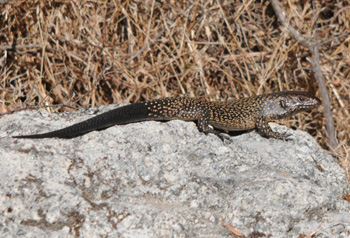 Driving back down Bolganup Road we stopped for 6 Maned (Australian Wood) Duck on a small waterhole and a little further on a flock of birds flitting from side to side of the roadside treetops held Western Gerygone and Inland Thornbill. A visit to the nearby Castle Rock Day Use area didn’t produce anything new, but there were c20 Western Grey Kangaroo feeding in the meadows near the car park. Back to Cheynes Beach c16.00 and just before the camp site we spotted 4 Dusky Woodswallow on the roadside telephone wires. We finished off the day with a stroll down the road from the camp site and saw 4 Red-winged Fairy Wren, 5 White-breasted Robin and heard c3 Noisy Scrubbird. As we walked from the campsite towards the beach an Osprey flew in from the bay with a sizeable fish in its talons and landed on a telegraph pole right in front of us: trust me, I had left the camera in the cabin as dusk was approaching.... another great photo opportunity missed! When we had arrived at Cheynes Beach we were assured Red-eared Firetail were common everywhere! Not so: despite several lengthy searches in appropriate areas we missed out completely.
Driving back down Bolganup Road we stopped for 6 Maned (Australian Wood) Duck on a small waterhole and a little further on a flock of birds flitting from side to side of the roadside treetops held Western Gerygone and Inland Thornbill. A visit to the nearby Castle Rock Day Use area didn’t produce anything new, but there were c20 Western Grey Kangaroo feeding in the meadows near the car park. Back to Cheynes Beach c16.00 and just before the camp site we spotted 4 Dusky Woodswallow on the roadside telephone wires. We finished off the day with a stroll down the road from the camp site and saw 4 Red-winged Fairy Wren, 5 White-breasted Robin and heard c3 Noisy Scrubbird. As we walked from the campsite towards the beach an Osprey flew in from the bay with a sizeable fish in its talons and landed on a telegraph pole right in front of us: trust me, I had left the camera in the cabin as dusk was approaching.... another great photo opportunity missed! When we had arrived at Cheynes Beach we were assured Red-eared Firetail were common everywhere! Not so: despite several lengthy searches in appropriate areas we missed out completely.
15th December – Cheynes Beach, Perth via Wagin
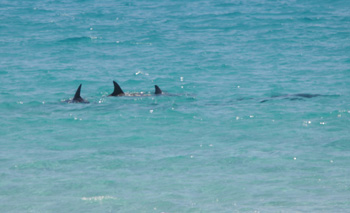 Another 05.30 start this morning in a final effort to catch the little skulkers. Rather than set of up the tracks into the scrub we walked down to the beach where a lone Common Sandpiper wandered along the tide line. We then walked around the perimeter of the campsite seeing some good birds, but nothing new at first; Galah & Western Rosella were eventually joined by 4 Regent Parrot and White-cheeked Honeyeater. A pair of Southern Emu Wren were a delightful find at the roadside leading to the campsite as we returned to our cabin for breakfast, where a King’s Skink was enjoying the early morning sunshine. We had just finished eating when one of our neighbours knocked on the door to let us know a Noisy Scrubbird had been calling and crossing the tracks from time to time near the toilet block by the beach. Dropping everything, I rushed down the road more in hope than expectation. I spent half an hour walking along the tracks, listening to a bird calling deep in the scrub. I eventually positioned myself at the junction of two tracks in the hope the bird would run across to the adjoining patch of scrub. Amanda joined me after a while to let me know we needed to get on the road and as we were chatting I looked over her shoulder just in time to see a bird scuttling across the track and out of sight again.
Another 05.30 start this morning in a final effort to catch the little skulkers. Rather than set of up the tracks into the scrub we walked down to the beach where a lone Common Sandpiper wandered along the tide line. We then walked around the perimeter of the campsite seeing some good birds, but nothing new at first; Galah & Western Rosella were eventually joined by 4 Regent Parrot and White-cheeked Honeyeater. A pair of Southern Emu Wren were a delightful find at the roadside leading to the campsite as we returned to our cabin for breakfast, where a King’s Skink was enjoying the early morning sunshine. We had just finished eating when one of our neighbours knocked on the door to let us know a Noisy Scrubbird had been calling and crossing the tracks from time to time near the toilet block by the beach. Dropping everything, I rushed down the road more in hope than expectation. I spent half an hour walking along the tracks, listening to a bird calling deep in the scrub. I eventually positioned myself at the junction of two tracks in the hope the bird would run across to the adjoining patch of scrub. Amanda joined me after a while to let me know we needed to get on the road and as we were chatting I looked over her shoulder just in time to see a bird scuttling across the track and out of sight again.  Not brilliant, but probably as good a sighting of Noisy Scrubbird as most people will get. At 09:30 we packed up and set off back to Perth, stopping almost immediately before we left the village to watch 8 Dolphins swimming across the bay. Along Cheyne Road we stopped to watch a Little Eagle overhead and a Heath Monitor at the side of the road. Rather than follow the main highway back to Perth we decided to take the longer, but more scenic inland route, leaving Highway 30 at Cranbrook, taking Highway 130 via Katanning and Wagin and heading back to Highway 30 from Narrogin. Highlights along the way included c12 Regent Parrot in the roadside trees and c10 White-cheeked Honeyeater in the park in Wagin, where we also encountered the biggest ram we had ever seen, including the largest ever pair of cojones! As we were driving along the highway about 45km south of Armadale and the South Western highway split, a cloud of black erupted over the road; pulling in to a fortuitously placed lay-by we were almost deafened by the noise as a flock of over 120 Black Cockatoo circled around and flew across the road. No doubt the flock contained a mixture of Carnaby’s & Baudin’s BC but they weren’t considerate enough to land nearby. We got back to Perth at 16:00 after a long hot drive and chilled out for the rest of the day.
Not brilliant, but probably as good a sighting of Noisy Scrubbird as most people will get. At 09:30 we packed up and set off back to Perth, stopping almost immediately before we left the village to watch 8 Dolphins swimming across the bay. Along Cheyne Road we stopped to watch a Little Eagle overhead and a Heath Monitor at the side of the road. Rather than follow the main highway back to Perth we decided to take the longer, but more scenic inland route, leaving Highway 30 at Cranbrook, taking Highway 130 via Katanning and Wagin and heading back to Highway 30 from Narrogin. Highlights along the way included c12 Regent Parrot in the roadside trees and c10 White-cheeked Honeyeater in the park in Wagin, where we also encountered the biggest ram we had ever seen, including the largest ever pair of cojones! As we were driving along the highway about 45km south of Armadale and the South Western highway split, a cloud of black erupted over the road; pulling in to a fortuitously placed lay-by we were almost deafened by the noise as a flock of over 120 Black Cockatoo circled around and flew across the road. No doubt the flock contained a mixture of Carnaby’s & Baudin’s BC but they weren’t considerate enough to land nearby. We got back to Perth at 16:00 after a long hot drive and chilled out for the rest of the day.
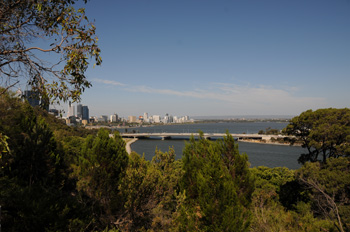 16th December – Herdsman Lake, Lake Monger & King’s Park
16th December – Herdsman Lake, Lake Monger & King’s Park
After yesterday’s long drive we decided to spend the day around the city. White-headed Stilt (c100), Crested Pigeon, Glossy Ibis (20) and Little Egret were new around the lakes whilst at King’s Park we added Rainbow Lorikeet, Spotted Pardalote and Australian Darter. The Botanical Gardens are full of interesting plant and tree species, beautifully maintained and, overlooking the city from the cliff tops, the setting is second to none.
17th December
Today we had a 3½ hour flight across three time zones to Melbourne: arriving late in the afternoon we picked up a Toyota Camry auto and drove to our city centre hotel. Little did we know at that stage the car would remain in the hotel garage for the duration of our stay in the city – a very expensive taxi ride to and from the airport.
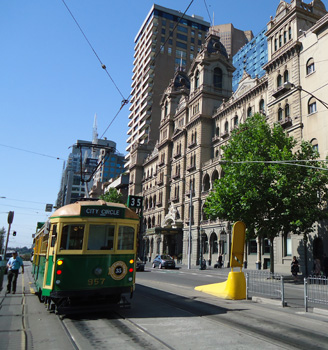 18th December – Melbourne
18th December – Melbourne
We spent the day exploring the city by tram. Tram rides in the CBD area are free and, although crowded at times, the trams are quite frequent and provide a great way to get to know the city, which was in the middle of a mini heatwave with temperatures building to the mid 30’s°C.
19th December – Melbourne, Point Addis, Anglesea, Lake Lorne & Serendip
Six months previously we had arranged to meet up with Steve Davidson for some guided birding around the Melbourne area and he picked us up at our hotel at 06.00. With temperatures predicted to top 40°C today the state had declared a Total Fire Ban which unfortunately meant no access to the Werribee Water Treatment Plant. We set off west from the city, heading for the coast. Before we reached our first destination we spotted Black Kite, Australian Hobby, Black-shouldered Kite and Brown Goshawk as we drove along. We stretched our legs at Point Addis and whilst we were still in the car park we briefly spotted our first Rufous Bristlebird. Walking along the tracks we heard other birds, but were not very co-operative: as we looked out over the ocean Amanda spotted two Hooded Dotterel on the beach below us and White-browed Scrubwren flitted from bush to bush across the paths. 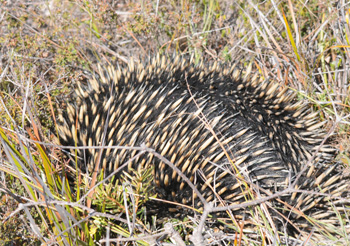 Our next stop was the Eumerella Flora Reserve at Anglesea where we nearly tripped over a pair of Brown Quail as they took flight from the side of the track. We saw Brown Thornbill in the bushes but generally birds were conspicuous by their absence and a Short-beaked Echidna was our only initial real find. As we were heading back to the car Steve finally heard one of our targets, Striated Fieldwren, singing nearby and we eventually found 3 or 4 more birds and enjoyed some very close views. Next we moved on to Anglesea Heath where the birds were a little more active and we picked up several species in quick succession along Coalmine Road: 2 Dusky Woodswallow, Golden Whistler, Rufous Whistler, White-eared Honeyeater, Satin Flycatcher, a pair of Crested Shriketit, Eastern Yellow Robin and a fleeting glimpse of 2 Blue-winged Parrot which we heard calling overhead. We briefly stopped by a couple of small lakes and as we watched a good array of common waterbirds a pristine male Swamp Harrier floated over the treetops and started hunting around the lake fringes. We moved on to another small lake at Aieries Inlet where Latham’s Snipe were regulars and spotted a pair almost straight away, whilst 3 Yellow-tailed Black Cockatoo clambered around the nearby treetops.
Our next stop was the Eumerella Flora Reserve at Anglesea where we nearly tripped over a pair of Brown Quail as they took flight from the side of the track. We saw Brown Thornbill in the bushes but generally birds were conspicuous by their absence and a Short-beaked Echidna was our only initial real find. As we were heading back to the car Steve finally heard one of our targets, Striated Fieldwren, singing nearby and we eventually found 3 or 4 more birds and enjoyed some very close views. Next we moved on to Anglesea Heath where the birds were a little more active and we picked up several species in quick succession along Coalmine Road: 2 Dusky Woodswallow, Golden Whistler, Rufous Whistler, White-eared Honeyeater, Satin Flycatcher, a pair of Crested Shriketit, Eastern Yellow Robin and a fleeting glimpse of 2 Blue-winged Parrot which we heard calling overhead. We briefly stopped by a couple of small lakes and as we watched a good array of common waterbirds a pristine male Swamp Harrier floated over the treetops and started hunting around the lake fringes. We moved on to another small lake at Aieries Inlet where Latham’s Snipe were regulars and spotted a pair almost straight away, whilst 3 Yellow-tailed Black Cockatoo clambered around the nearby treetops. 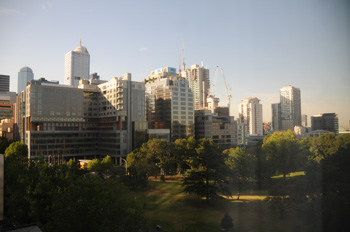 Next stop was Lake Lorne at Drysdale where we found another pair of Latham’s Snipe, a single Red-rumped Parrot and good numbers of ducks including, Maned, Blue-billed, Pink-eared, Hardhead, Australian Shoveler and finally c20 Freckled Duck, our principal target which we had missed around Perth. As we drove along to Serendip Sanctuary we spotted the first of c30 Cape Barren Goose, 2 more Red-rumped Parrot, Grey Shrikethrush, White plumed Honeyeater and several White-winged Chough. With temperatures reaching 42-45°C we were pleased to return to our hotel at 16:00 for several glasses of ice-cold water.
Next stop was Lake Lorne at Drysdale where we found another pair of Latham’s Snipe, a single Red-rumped Parrot and good numbers of ducks including, Maned, Blue-billed, Pink-eared, Hardhead, Australian Shoveler and finally c20 Freckled Duck, our principal target which we had missed around Perth. As we drove along to Serendip Sanctuary we spotted the first of c30 Cape Barren Goose, 2 more Red-rumped Parrot, Grey Shrikethrush, White plumed Honeyeater and several White-winged Chough. With temperatures reaching 42-45°C we were pleased to return to our hotel at 16:00 for several glasses of ice-cold water.
20th December – Mount Donna Buang
With the Total Fire Ban still in place and forest fires raging in one of the areas Steve had planned to visit, we set off for the rainforest area around Mount Donna Buang near Warburton at 06:00. Winds had picked up overnight and temperatures were set to soar again and our expectations were therefore quite low as conditions were far from ideal for birding, 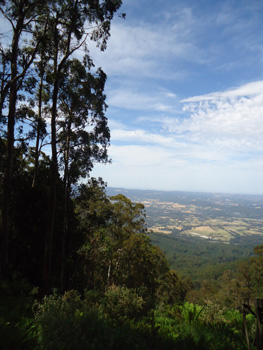 so anything new we could pick up would be a bonus. As we gained height we stopped from time to time if Steve heard a bird calling or the habitat looked promising. Birding was inevitably slow, but we soon started to pick up some new species: King Parrot, Eastern Spinebill, Olive Whistler, Golden Whistler, Grey Currawong, Brush Cuckoo, Gang-gang Cockatoo and several Flame Robin were added before we heard one of our main target species, Pink Robin, calling nearby. After searching for a few minutes we eventually found two calling birds and managed to get excellent views. Other wildlife included a Swamp Wallaby which ran along the road briefly in front of us and the beautiful Macleays Swallowtail. Moving on we also found Yellow-faced Honeyeater, Pied Currawong, Crescent Honeyeater and heard Shining Bronze Cuckoo, but the bird eluded us. We were just about to give up on our other main target and return to Steve’s vehicle when movement on the ground, under some bushes, caught our eyes and ferreting about in the leaf litter were 2 Bassian Thrush. A little further on we saw several Large-billed Scrubwren before heading back to Melbourne at 14.00 for some welcome refreshments, with temperatures having soared to c38°C. The weather finally broke late afternoon as clouds gathered and it rained from 16:00 to 17:30.
so anything new we could pick up would be a bonus. As we gained height we stopped from time to time if Steve heard a bird calling or the habitat looked promising. Birding was inevitably slow, but we soon started to pick up some new species: King Parrot, Eastern Spinebill, Olive Whistler, Golden Whistler, Grey Currawong, Brush Cuckoo, Gang-gang Cockatoo and several Flame Robin were added before we heard one of our main target species, Pink Robin, calling nearby. After searching for a few minutes we eventually found two calling birds and managed to get excellent views. Other wildlife included a Swamp Wallaby which ran along the road briefly in front of us and the beautiful Macleays Swallowtail. Moving on we also found Yellow-faced Honeyeater, Pied Currawong, Crescent Honeyeater and heard Shining Bronze Cuckoo, but the bird eluded us. We were just about to give up on our other main target and return to Steve’s vehicle when movement on the ground, under some bushes, caught our eyes and ferreting about in the leaf litter were 2 Bassian Thrush. A little further on we saw several Large-billed Scrubwren before heading back to Melbourne at 14.00 for some welcome refreshments, with temperatures having soared to c38°C. The weather finally broke late afternoon as clouds gathered and it rained from 16:00 to 17:30.
21st December – Melbourne Botanic Gardens
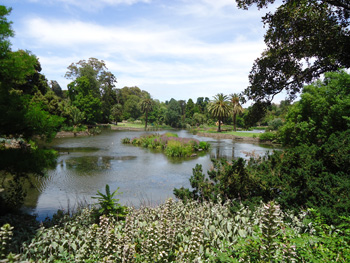 Today was a non birding day as we met up with our friends from Sydney, Mark & Mia. Walking around the Botanic Gardens we did see several Bell Miner, 3 Noisy Miner and Chestnut Teal to keep the list ticking over. We had an excellent late lunch at the Red Dragon Chinese Restaurant on the south bank of the River Yarra and, although still quite hot, temperatures peaked at a much more pleasant 22-25°C today.
Today was a non birding day as we met up with our friends from Sydney, Mark & Mia. Walking around the Botanic Gardens we did see several Bell Miner, 3 Noisy Miner and Chestnut Teal to keep the list ticking over. We had an excellent late lunch at the Red Dragon Chinese Restaurant on the south bank of the River Yarra and, although still quite hot, temperatures peaked at a much more pleasant 22-25°C today.
22nd December – Western Water Treatment Works then Newport Lakes
With temperatures finally back to something like normal for the time of the year the Total Fire Ban had been lifted and we were finally able to visit Werribee with Steve Davidson. He picked us up at the hotel at 08.00 and as we headed west out of Melbourne we saw 2 Caspian Tern over River Yarra. As we were flying to New Zealand early the next morning we had a dinner date with Mark & Mia and Mark’s sister Jill at Bacaro Italian Restaurant on Little Collins Street (the food was excellent by the way), we only spent about 3 hours at the Water Treatment Plant, but we could have spent all day there. As you would expect, the area is massive, flat and teeming with birds. 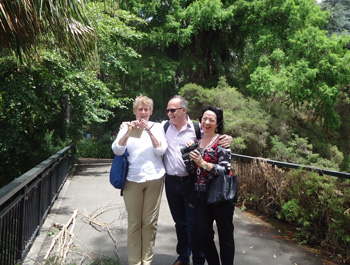 With the benefit of Steve’s permit we were able to visit most of the more important areas, with access via padlocked gates. Surprisingly we were not troubled by flies at all and with temperatures c24°C we had a super morning’s birding see 61 species in total and didn’t really want to leave. Species seen included Dusky Woodswallow, Fairy Martin, Little Raven, c5000 Australian Shelduck, Whiskered Tern, 4 Brogla, Golden Headed Cisticola, Greenshank, Sharp-tailed Sandpiper, Red-necked Stint, Banded Stilt, c200 Red-necked Avocet, Curlew Sandpiper,( including one pristine specimen in full breeding plumage), White –fronted Chat, Zebra Finch, Horsfield’s Bushlark, Australian Reed Warbler, 2 Red-capped Plover, a single Fairy Tern, Horsfield’s Bronze Cuckoo, Whistling Kite, Superb Fairywren, juvenile Spotted Harrier on the nest, 3 Black-tailed Nativehen and 2 Black-fronted Dotterel. In addition we heard, but didn’t see, Little Grassbird and Stubble Quail. Other wildlife included Hare, a Red-bellied Black Snake and we heard a lot of Growling Grass Frogs. Returning to Melbourne for 13.00 we made a swift detour to Newport Lakes, Steve’s local patch, where he managed to show us another of our target species, Nankeen Night Heron.
With the benefit of Steve’s permit we were able to visit most of the more important areas, with access via padlocked gates. Surprisingly we were not troubled by flies at all and with temperatures c24°C we had a super morning’s birding see 61 species in total and didn’t really want to leave. Species seen included Dusky Woodswallow, Fairy Martin, Little Raven, c5000 Australian Shelduck, Whiskered Tern, 4 Brogla, Golden Headed Cisticola, Greenshank, Sharp-tailed Sandpiper, Red-necked Stint, Banded Stilt, c200 Red-necked Avocet, Curlew Sandpiper,( including one pristine specimen in full breeding plumage), White –fronted Chat, Zebra Finch, Horsfield’s Bushlark, Australian Reed Warbler, 2 Red-capped Plover, a single Fairy Tern, Horsfield’s Bronze Cuckoo, Whistling Kite, Superb Fairywren, juvenile Spotted Harrier on the nest, 3 Black-tailed Nativehen and 2 Black-fronted Dotterel. In addition we heard, but didn’t see, Little Grassbird and Stubble Quail. Other wildlife included Hare, a Red-bellied Black Snake and we heard a lot of Growling Grass Frogs. Returning to Melbourne for 13.00 we made a swift detour to Newport Lakes, Steve’s local patch, where he managed to show us another of our target species, Nankeen Night Heron.
Skip to Sydney - 15th January 2016
NEW ZEALAND
23rd December – Fly to New Zealand
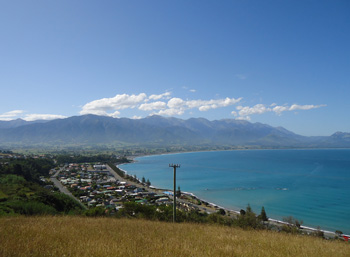 With our flight at 09:05 we were up before 05.00 and at the airport at 06.30: our flight had originally been 2 hours later, meaning the car would be returned 2+ hours earlier after its week of inactivity and we hadn’t thought through the implications. East Coast Car Rentals, sited c 3kms away from the airport, was closed, with instructions to post the keys through a letterbox out of hours and we still needed to get to the airport to catch our flight! We tried phoning all the numbers we had for them but to no avail. In the end we drove to the car rental section at the airport and after talking to the ladies on the desk at Europcar, they tried to contact East Coast as well with no success. Eventually we left the car with Europcar and they said they would contact East Coast when the office opened and arrange for the car to be picked up. What stars! We had used Europcar in Perth and were using them again in New Zealand and will use them in future, even if they are more expensive. Just as our flight was called we managed to talk to the East Coast office and they confirmed they had collected the car and all was well. What a relief. Our car in South Island was a lurid green Holden saloon and was a pleasure to drive. We left Christchurch immediately and drove straight to Kaikoura. Most of the birds seen on the journey were European rather than native but we did manage Swamp Harrier, Grey Duck, Little Black Cormorant and Kelp Gull. Having had a successful trip to New Zealand in 1998 we only had a few potential lifers. As a result, we planned this trip with that in mind with several pre-arranged Pelagics and Kiwi hunts as these were the two areas we had missed out on previously.
With our flight at 09:05 we were up before 05.00 and at the airport at 06.30: our flight had originally been 2 hours later, meaning the car would be returned 2+ hours earlier after its week of inactivity and we hadn’t thought through the implications. East Coast Car Rentals, sited c 3kms away from the airport, was closed, with instructions to post the keys through a letterbox out of hours and we still needed to get to the airport to catch our flight! We tried phoning all the numbers we had for them but to no avail. In the end we drove to the car rental section at the airport and after talking to the ladies on the desk at Europcar, they tried to contact East Coast as well with no success. Eventually we left the car with Europcar and they said they would contact East Coast when the office opened and arrange for the car to be picked up. What stars! We had used Europcar in Perth and were using them again in New Zealand and will use them in future, even if they are more expensive. Just as our flight was called we managed to talk to the East Coast office and they confirmed they had collected the car and all was well. What a relief. Our car in South Island was a lurid green Holden saloon and was a pleasure to drive. We left Christchurch immediately and drove straight to Kaikoura. Most of the birds seen on the journey were European rather than native but we did manage Swamp Harrier, Grey Duck, Little Black Cormorant and Kelp Gull. Having had a successful trip to New Zealand in 1998 we only had a few potential lifers. As a result, we planned this trip with that in mind with several pre-arranged Pelagics and Kiwi hunts as these were the two areas we had missed out on previously.
24th December – Kaikoura seabird pelagic then north along coast and south to Peninsula Seal Colony (Point Kean) & Limestone Bay
.JPG) 17 years ago we went whale watching in Kaikoura but had missed the seabird pelagic there; we booked 6 months in advance with Albatross Encounter and had been looking forward to this trip since then. We left shore c 09.00 and were not disappointed; our guide and skipper for the trip, Tracy, was able to show us Snares Cape Petrel, Antipodean (Gibson’s) Albatross, both 2 Northern & 3 Southern Royal Albatross, 1 Black-browed, 3 Shy (New Zealand White-capped) & 10 Salvin’s Albatross, more than 20 Northern Giant Petrel and 1 Southern Giant Petrel, c6 White-chinned and 3 Westland Petrel, a single Fairy Prion, 2 Buller’s, 3 Flesh-footed, 1 Sooty and c70 Hutton’s Shearwater as well as several more common species. We had superb close-ups of all the species apart from the Fairy Prion which was spotted just as it flew away from the boat. What a way to spend Christmas Eve! After a spot of lunch at the Albatross Encounter café we drove north up a minor coast road, just beyond the Whale Watching centre. It was quite disconcerting to know we were in New Zealand and driving through mixed farmland hearing numerous Skylark, Chaffinch, Goldfinch, Greenfinch, Yellowhammer and Dunnock all around us. We did also see a single Paradise Shelduck and 6 South Island Oystercatcher.
17 years ago we went whale watching in Kaikoura but had missed the seabird pelagic there; we booked 6 months in advance with Albatross Encounter and had been looking forward to this trip since then. We left shore c 09.00 and were not disappointed; our guide and skipper for the trip, Tracy, was able to show us Snares Cape Petrel, Antipodean (Gibson’s) Albatross, both 2 Northern & 3 Southern Royal Albatross, 1 Black-browed, 3 Shy (New Zealand White-capped) & 10 Salvin’s Albatross, more than 20 Northern Giant Petrel and 1 Southern Giant Petrel, c6 White-chinned and 3 Westland Petrel, a single Fairy Prion, 2 Buller’s, 3 Flesh-footed, 1 Sooty and c70 Hutton’s Shearwater as well as several more common species. We had superb close-ups of all the species apart from the Fairy Prion which was spotted just as it flew away from the boat. What a way to spend Christmas Eve! After a spot of lunch at the Albatross Encounter café we drove north up a minor coast road, just beyond the Whale Watching centre. It was quite disconcerting to know we were in New Zealand and driving through mixed farmland hearing numerous Skylark, Chaffinch, Goldfinch, Greenfinch, Yellowhammer and Dunnock all around us. We did also see a single Paradise Shelduck and 6 South Island Oystercatcher. 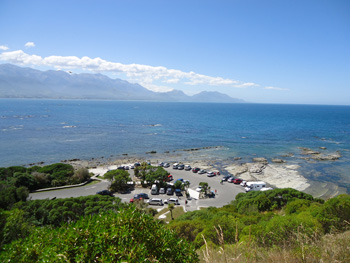 We then moved on to Point Kean and the Peninsula Seal Colony where there were New Zealand Fur Seals everywhere, plus the occasional Variable Oystercatcher, c4 (Grey-breasted) Silvereye and a single Northern Giant Petrel close in shore. In the fields on the cliffs above the seal colony we heard, then finally spotted a single Cirl Bunting. We finished the day at Limestone Bay where 4 Spotted Shag were the only addition to the list.
We then moved on to Point Kean and the Peninsula Seal Colony where there were New Zealand Fur Seals everywhere, plus the occasional Variable Oystercatcher, c4 (Grey-breasted) Silvereye and a single Northern Giant Petrel close in shore. In the fields on the cliffs above the seal colony we heard, then finally spotted a single Cirl Bunting. We finished the day at Limestone Bay where 4 Spotted Shag were the only addition to the list.
25th December
After a lazy morning we went to Tuti’s Restaurant for Christmas lunch then drove south from Kaikoura for c30kms stopping where the habitat looked interesting or we saw groups of birds. We saw the usual selection of cormorants and oystercatchers, plus a single Northern Giant Petrel, Double-banded Plover, 5 Masked Lapwing, 2 White-headed Stilt and the ever present British contingent.
26th December – north of Kaikoura and inland then Whale Watching & Ohau Point NZ Fur Seal Sanctuary
Opening the curtains and walking on to the balcony this morning we were greeted with a pod of c40 Dusky Dolphin swimming across the bay. 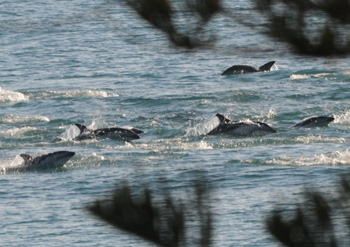 What a way to start the day! Nothing new around Kaikoura, but we spent some time watching 4 Swamp Harrier quartering the fields to the background music provided by several Skylark. Our Whale Watching cruise started with a bang with a pair of Orca quite close in shore, followed by 3 separate Sperm Whale, one of which we managed to see twice as they surfaced for air. Nothing new on the seabird front, but we had good views of 2 Antipodean (Gibson’s) Albatross, a single Black-browed and 4 Slavin’s Albatross, c5 of the seemingly ever present Northern Giant Petrel plus c100 Hutton’s Shearwater. Driving north to Ohau Point we saw 9 Northern Giant Petrel loafing on the water just beyond the rocks at the NZ Fur Seal colony, c8 White-fronted Tern and a White-faced Heron pottered about on the rocks and 3 NZ Pigeon and a Grey Gerygone were in the road side trees.
What a way to start the day! Nothing new around Kaikoura, but we spent some time watching 4 Swamp Harrier quartering the fields to the background music provided by several Skylark. Our Whale Watching cruise started with a bang with a pair of Orca quite close in shore, followed by 3 separate Sperm Whale, one of which we managed to see twice as they surfaced for air. Nothing new on the seabird front, but we had good views of 2 Antipodean (Gibson’s) Albatross, a single Black-browed and 4 Slavin’s Albatross, c5 of the seemingly ever present Northern Giant Petrel plus c100 Hutton’s Shearwater. Driving north to Ohau Point we saw 9 Northern Giant Petrel loafing on the water just beyond the rocks at the NZ Fur Seal colony, c8 White-fronted Tern and a White-faced Heron pottered about on the rocks and 3 NZ Pigeon and a Grey Gerygone were in the road side trees.
27th December – Drive south to Dunedin via St Anne’s Lagoon near Cheviot
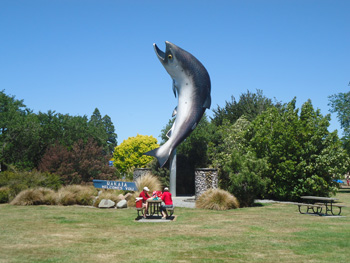 With a long drive ahead of us we stopped just south of Kaikoura at St Anne’s Lagoon. There were c300 Paradise Shelduck on the water and Eastern Australian Swamphen, NZ Grebe and NZ Scaup were the only other species of note. It was c25° and sunny for the 7hs+ drive, but, as with several journeys in New Zealand, we chose to have long drives followed by a two night stopover rather than make shorter trips and move on every day. Swamp Harrier were common all the way, as they are throughout most of the North and South Islands.
With a long drive ahead of us we stopped just south of Kaikoura at St Anne’s Lagoon. There were c300 Paradise Shelduck on the water and Eastern Australian Swamphen, NZ Grebe and NZ Scaup were the only other species of note. It was c25° and sunny for the 7hs+ drive, but, as with several journeys in New Zealand, we chose to have long drives followed by a two night stopover rather than make shorter trips and move on every day. Swamp Harrier were common all the way, as they are throughout most of the North and South Islands.
28th December – Dunedin: Otago Peninsula including MacAndrew Bay, Dick Road, Papanui Inlet, Hooper’s Inlet and Orokonui ecosanctuary, just north of Dunedin
 Spotted Shag, Little Pied Cormorant & White-fronted Tern were the first species we encountered in MacAndrew Bay, swiftly followed by 5 Black-billed Gull, along with the Silver (Red-billed) Gull and Kelp Gull we saw everywhere. Moving on to Dick Road we found 2 Australian White Ibis, 3 Royal Spoonbill along with all the more common species and 2 Welcome Swallow. Papanui Inlet and Hooper’s Inlet held similar birds plus c50 Grey Teal and 3 adult Swamphen with 2 juveniles. Mid afternoon we moved north to the Orokonui ecosanctuary; inside the protective fence both Tui and Bellbird were common and we managed to see a single Takahe, South Island Rifleman and a pair of Eastern Rosella.
Spotted Shag, Little Pied Cormorant & White-fronted Tern were the first species we encountered in MacAndrew Bay, swiftly followed by 5 Black-billed Gull, along with the Silver (Red-billed) Gull and Kelp Gull we saw everywhere. Moving on to Dick Road we found 2 Australian White Ibis, 3 Royal Spoonbill along with all the more common species and 2 Welcome Swallow. Papanui Inlet and Hooper’s Inlet held similar birds plus c50 Grey Teal and 3 adult Swamphen with 2 juveniles. Mid afternoon we moved north to the Orokonui ecosanctuary; inside the protective fence both Tui and Bellbird were common and we managed to see a single Takahe, South Island Rifleman and a pair of Eastern Rosella.
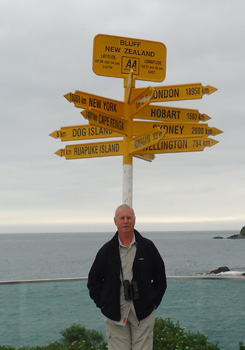 29th December – Drive south to Invercargill via the Catlins & finally to Bluff for ferry to Stewart Island & SI Lodge
29th December – Drive south to Invercargill via the Catlins & finally to Bluff for ferry to Stewart Island & SI Lodge
Another longish drive today, again with all the usual species, with c60+ Masked Lapwing in several fields and Swamp Harrier around every corner. Rather than follow the main Highways all the way we decided to follow the Catlins route for a bit of variety and came across c10 Black-billed Gull, several Tui and, as we neared Invercargill c10 Bar-tailed Godwit & c6 Royal Spoonbill on some mud banks. Around Bluff we saw several of both Oystercatchers, a couple of Spotted Shag and single Great Cormorant & White-fronted Tern. At Stewart Island Lodge we had Tui and 3 Kaka from the balcony. In the evening we had arranged to go Kiwi Watching with Phillip Smith to Ocean Beach at least 6 months in advance. The trip takes c1hour by boat, which can accommodate quite large parties (20+) and involves up to 2 hours walking to and from the beaches with torches in pitch black. From the boat we saw c10 Little Penguin, 5 species of Cormorant/Shag, including 4 Stewart Shag and a single Shy (NZ White-capped) Albatross. At Ocean Beach after a couple of hours wandering about we eventually saw a single Southern (Stewart Island) Brown Kiwi and were able to watch the bird feeding for 5 minutes+. As we returned to Halfmoon Bay at almost 1am we saw several Prion flying around the boat but were unable to say whether they were Fairy or Broad-billed.
30th December – Pelagic from Half Moon Bay & Ulva Island
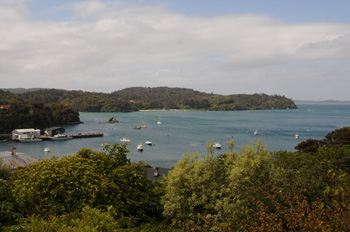 We were breakfasted and out again by 08.30 the following morning for another pelagic with Matt of Rakiura Charters for c 3 hours and once again had excellent close up views of several of our seabird targets, despite the sea having a sizeable swell once we cleared the islands. Our haul included 2 Southern Royal & 1 Northern Royal Albatross, c20 Shy (NZ White-capped) Albatross, 3 Buller’s Albatross, a single Salvin’s Albatross, c3 Northern Giant Petrel, c4 Snares Cape Petrel, a Common Diving Petrel, a (Subantarctic) Brown Skua and c20 Sooty Shearwater. On our way to Ulva Island we passed close by the local colony of Stewart Shag and saw a couple of Stewart Island Weka on nearby beaches, plus a South Island Fantail. Temperatures had risen to c16° and it had been cloudy all morning, with steady rain setting in for a short period just before we reached the island. Tui seemed to be all around us and as we walked around the island’s tracks we spotted Stewart Island Robin, South Island Tomtit, c3 Kaka, a single Red-fronted Parakeet, Pipipi (Brown Creeper) and 3 beautiful Yellowhead, our main target and one of our few land based lifers in New Zealand. We were picked up by the water-taxi and returned to Stewart Island Lodge after a couple of hours.
We were breakfasted and out again by 08.30 the following morning for another pelagic with Matt of Rakiura Charters for c 3 hours and once again had excellent close up views of several of our seabird targets, despite the sea having a sizeable swell once we cleared the islands. Our haul included 2 Southern Royal & 1 Northern Royal Albatross, c20 Shy (NZ White-capped) Albatross, 3 Buller’s Albatross, a single Salvin’s Albatross, c3 Northern Giant Petrel, c4 Snares Cape Petrel, a Common Diving Petrel, a (Subantarctic) Brown Skua and c20 Sooty Shearwater. On our way to Ulva Island we passed close by the local colony of Stewart Shag and saw a couple of Stewart Island Weka on nearby beaches, plus a South Island Fantail. Temperatures had risen to c16° and it had been cloudy all morning, with steady rain setting in for a short period just before we reached the island. Tui seemed to be all around us and as we walked around the island’s tracks we spotted Stewart Island Robin, South Island Tomtit, c3 Kaka, a single Red-fronted Parakeet, Pipipi (Brown Creeper) and 3 beautiful Yellowhead, our main target and one of our few land based lifers in New Zealand. We were picked up by the water-taxi and returned to Stewart Island Lodge after a couple of hours.
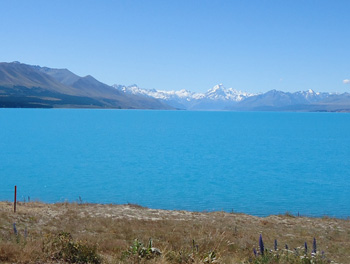 31st December – Bluff & Christchurch
31st December – Bluff & Christchurch
We caught the 9.30 ferry across the Foveaux Straight to Bluff, picked up our car and then set off on the 7hrs+ drive to Christchurch. On the ferry crossing we saw 2 Sooty Shearwater, Northern Giant Petrel and c8 Common Diving Petrel. For a bit of variety we travelled via Gore, Roxborough, Twizel & Geraldine, had superb scenery & views of Mt Cook and arrived in Christchurch around 19.30. Along the way we saw most of the usual species including Black-billed Gull, Yellowhammer and Sacred Kingfisher. On arrival at our motel we were advised there was a party taking place in the nearby Hagley Park to celebrate the New Year, with fireworks at midnight. After a long day we were so knackered we just did the laundry and went to bed!
1st January 2016 – Christchurch: New Brighton, Marine Parade, Avon-Heathcote Estuary, Lincoln Wetlands, Christchurch Botanic Gardens & Hagley Park
New Year’s Day dawned bright and cloudless and after an early breakfast in the city centre we set off to explore the surrounding countryside. The estuary and wetlands were quite disappointing: apart from c200 Bar-tailed Godwit, the usual Oystercatchers and Masked Lapwing there were no waders about and few waterbirds. By lunchtime it was warm & sunny with temperatures reaching c23°. Lesser Redpoll was the only new bird in Christchurch Botanic Gardens, where we also saw a tiny baby Hedgehog.
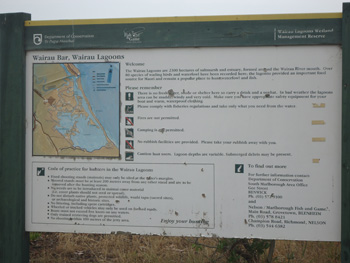 2nd January – North to Picton via Lake Elterwater & Wairau Lagoon
2nd January – North to Picton via Lake Elterwater & Wairau Lagoon
Today was much cooler at c15°C, cloudier and rained from time to time before setting in with a vengeance late afternoon. Birds were quite distant at Lake Elterwater with nothing new in evidence: c10 Double-banded Plover were the only species of note. The last kilometre of the 10km road to Wairau Lagoons was gravel. Once there we saw 4 Caspian Tern, 8 Royal Spoonbill, 2 Black-fronted Tern, with c20 Spotted Shag and c30 Australian Pied Cormorant roosting on the pebble strewn sand banks. By the time we arrived late in the afternoon, Picton was miserable, grey and very wet.
3rd January – Marlborough Sound boat trip
This was supposedly a “Bird watching” trip but of c20 people on board, we were the only birders and with inclement weather – cold, grey, wet and windy – not much emphasis was placed on birds. We left Picton at 13.30 and returned at 18.00 after travelling out in Marlborough Sound as far as Motuara Island. On the way out we saw numerous New Zealand Fur Seals, c50 Fluttering Shearwater and 6 Australasian Gannet, whilst our brief stay on Motuara Island produced a single Bellbird, South Island Saddleback and 2 South Island Robin. On our way back to Picton we detoured to visit a King Shag breeding colony where we saw c20 birds, another of our lifer targets, and shortly thereafter we came across c6 Hector’s Dolphin.
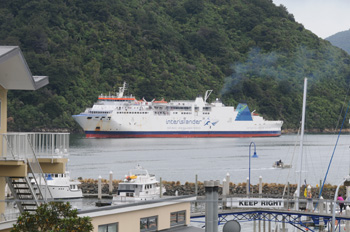 4th January – Interisland Ferry to Wellington and Paraparaumu via Waikanae Estuary
4th January – Interisland Ferry to Wellington and Paraparaumu via Waikanae Estuary
We dropped our hire car off at the Picton ferry terminal and caught the 10.45 ferry to North Island. Although it had stopped raining overnight, winds were still strong and a medium swell was promised for the crossing. In addition to a couple of White-fronted Tern, we managed to pick out 2 Salvin’s Albatross, 2 Northern Giant Petrel, Buller’s Shearwater, Flesh-footed Shearwater and c10 Fairy Prion. On our way to our accommodation at Paraparaumu we visited the Waikanae Estuary, a little further north, where we saw a single Caspian Tern in addition to over 100 White-fronted Tern.
5th January – Ferry to Kapiti Island
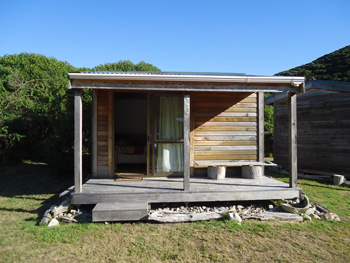 Having originally been told we were on the 09.00 ferry, we were moved to the 09.45 boat and landed at Rangatira Point around 10.00. There were c50 Fluttering Shearwater on the water as we crossed. After a brief introduction to the island by one of the “rangers” we were left to our own devices until we were scheduled to be picked up at 15.15 and taken to the north end of the Island for our overnight stay. Having decided we were not going to attempt to climb all the way to the summit, we set off up the Wilkinson Track to feeding station which is c2km and about half way along. This is supposedly the easier of the two tracks, but it is very steep in places and although we stopped quite frequently, we both felt quite unfit. Birds were an infrequent distraction, but we did manage to find Red-fronted Parakeet, several Whitehead, Grey Gerygone, Bellbird, 4 NI Saddleback, 2 Stitchbird and NI Fantail. Returning to sea level NI Kaka, Tui, NI Weka and NZ Pigeon were everywhere, and we saw the resident 3 South Island Takahe plus 1 juvenile and a solitary Purple Swamphen.
Having originally been told we were on the 09.00 ferry, we were moved to the 09.45 boat and landed at Rangatira Point around 10.00. There were c50 Fluttering Shearwater on the water as we crossed. After a brief introduction to the island by one of the “rangers” we were left to our own devices until we were scheduled to be picked up at 15.15 and taken to the north end of the Island for our overnight stay. Having decided we were not going to attempt to climb all the way to the summit, we set off up the Wilkinson Track to feeding station which is c2km and about half way along. This is supposedly the easier of the two tracks, but it is very steep in places and although we stopped quite frequently, we both felt quite unfit. Birds were an infrequent distraction, but we did manage to find Red-fronted Parakeet, several Whitehead, Grey Gerygone, Bellbird, 4 NI Saddleback, 2 Stitchbird and NI Fantail. Returning to sea level NI Kaka, Tui, NI Weka and NZ Pigeon were everywhere, and we saw the resident 3 South Island Takahe plus 1 juvenile and a solitary Purple Swamphen.
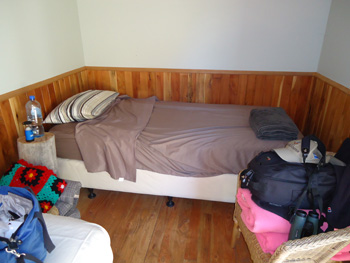 Arriving at the north end we walked about 1 kilometre with our overnight bags and camera gear etc to the lodge, where we were told to take our shoes off in the building, which was a bit of a surprise as the floors were polished wood. After another introductory talk and being surreptitiously given our towels* we were shown to our accommodation along with the other 18 overnight guests (*despite being assured twice by email, in the months preceding our departure, that both bedding and towels were provided, it appears towels most certainly are not and we were made aware we were a special exception!). I use the word accommodation in the loosest sense of the word: maybe we are getting soft in our old age but we do like some creature comforts. When we had booked our overnight stay over 6 months in advance of our trip, it was on the basis we understood we had reserved en suite accommodation. Our chalet was little more than a garden shed with a sliding door: there was just enough room for two single beds, a small chair and two upended logs serving as rickety bedside tables - Nowhere to put our gear other than the floor and then, virtually nowhere to walk. No electricity and no running water; two showers and toilets attached to the lodge for 20+ guests.
Arriving at the north end we walked about 1 kilometre with our overnight bags and camera gear etc to the lodge, where we were told to take our shoes off in the building, which was a bit of a surprise as the floors were polished wood. After another introductory talk and being surreptitiously given our towels* we were shown to our accommodation along with the other 18 overnight guests (*despite being assured twice by email, in the months preceding our departure, that both bedding and towels were provided, it appears towels most certainly are not and we were made aware we were a special exception!). I use the word accommodation in the loosest sense of the word: maybe we are getting soft in our old age but we do like some creature comforts. When we had booked our overnight stay over 6 months in advance of our trip, it was on the basis we understood we had reserved en suite accommodation. Our chalet was little more than a garden shed with a sliding door: there was just enough room for two single beds, a small chair and two upended logs serving as rickety bedside tables - Nowhere to put our gear other than the floor and then, virtually nowhere to walk. No electricity and no running water; two showers and toilets attached to the lodge for 20+ guests. 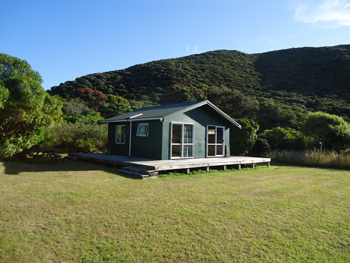 The beds were unmade with the musty smelling bedding neatly piled on top. Welcome to luxury!! I went back to the office to find out what was going on and why we didn’t have en suite facilities, to be told there was only one such cabin and this time of the year it was not available as it was reserved for use by the “family”. I asked to be taken off the island, only to be told the boat had left and would not be back until morning. We stayed in some super apartments and hotels on our trip around Australia and New Zealand and this overnight stop, albeit including food and transport, was the most expensive during our stay at NZ$710 for the two of us. Moreover the food was only adequate at best. Perhaps there is something wrong with us....all the other inmates seemed to be enjoying their rustic experience and were behaving as though all the deprivation etc was normal. The much cheaper option of staying overnight on Tiritiri Matangi seems a better bet if you want to see Little Spotted Kiwi.
The beds were unmade with the musty smelling bedding neatly piled on top. Welcome to luxury!! I went back to the office to find out what was going on and why we didn’t have en suite facilities, to be told there was only one such cabin and this time of the year it was not available as it was reserved for use by the “family”. I asked to be taken off the island, only to be told the boat had left and would not be back until morning. We stayed in some super apartments and hotels on our trip around Australia and New Zealand and this overnight stop, albeit including food and transport, was the most expensive during our stay at NZ$710 for the two of us. Moreover the food was only adequate at best. Perhaps there is something wrong with us....all the other inmates seemed to be enjoying their rustic experience and were behaving as though all the deprivation etc was normal. The much cheaper option of staying overnight on Tiritiri Matangi seems a better bet if you want to see Little Spotted Kiwi.
At 21.30 all 20 guests set out with torches to see kiwis accompanied by two guides. We heard 2 Little Spotted Kiwi and c3 Morepork, but only 3 guests at the front of the party (we were spread out on the narrow forest tracks) claimed to have briefly seen a kiwi. 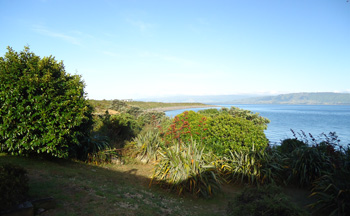 Back at the huts, as we walked to the toilets to clean our teeth etc the pitch black around us was lit up as another of the guests was creeping around looking for a Little Penguin which he informed us had disappeared under our accommodation. Amanda dropped an earring on the floor as she got in bed; she soon began to wish she hadn’t as she looked under the bed trying to find it. She had a dreadful night’s sleep, being buzzed by mosquitoes and, awakened c2am for a drink of water to find 2 giant Wetta (large grasshopper types) crawling over her soda water bottle and the bedside table. We had a long drive ahead of us the following day and had therefore, thankfully as it turned out, arranged to leave early, rather than c15.30 with the other guests. The ferry to pick us up in the morning was about an hour late and I was under strict instructions not to complain or say anything at all, just in case we were not allowed to leave!
Back at the huts, as we walked to the toilets to clean our teeth etc the pitch black around us was lit up as another of the guests was creeping around looking for a Little Penguin which he informed us had disappeared under our accommodation. Amanda dropped an earring on the floor as she got in bed; she soon began to wish she hadn’t as she looked under the bed trying to find it. She had a dreadful night’s sleep, being buzzed by mosquitoes and, awakened c2am for a drink of water to find 2 giant Wetta (large grasshopper types) crawling over her soda water bottle and the bedside table. We had a long drive ahead of us the following day and had therefore, thankfully as it turned out, arranged to leave early, rather than c15.30 with the other guests. The ferry to pick us up in the morning was about an hour late and I was under strict instructions not to complain or say anything at all, just in case we were not allowed to leave!
6th January – Ferry to Paraparaumu & onwards to Napier
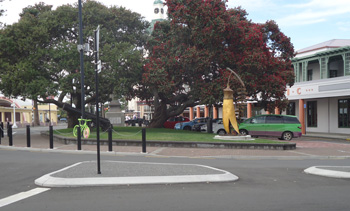 Whilst waiting for the ferry we saw a lone Pacific Reef Heron fly across the small bay as well as a good selection of the more common species around. As we approached the beach at Paraparaumu it was obvious there was a large shoal of small fish close to the shore; there was a feeding frenzy involving c8 Sooty Shearwater, c400 Fluttering Shearwater, numerous White-fronted Tern, Kelp and Red-billed Gull plus c10 Australian Pied Cormorant. We arrived in Napier around 14.30 and had never been so pleased to settle in to our clean and comfortable room at the Pebble Beach Motor Inn, costing a fraction of our stay on Kapiti Island. No new birds today, but Napier, with its Art Deco buildings, was well worth a visit on our way north to Auckland.
Whilst waiting for the ferry we saw a lone Pacific Reef Heron fly across the small bay as well as a good selection of the more common species around. As we approached the beach at Paraparaumu it was obvious there was a large shoal of small fish close to the shore; there was a feeding frenzy involving c8 Sooty Shearwater, c400 Fluttering Shearwater, numerous White-fronted Tern, Kelp and Red-billed Gull plus c10 Australian Pied Cormorant. We arrived in Napier around 14.30 and had never been so pleased to settle in to our clean and comfortable room at the Pebble Beach Motor Inn, costing a fraction of our stay on Kapiti Island. No new birds today, but Napier, with its Art Deco buildings, was well worth a visit on our way north to Auckland.
7th January – Auckland via Ahuriri & Lake Taupo
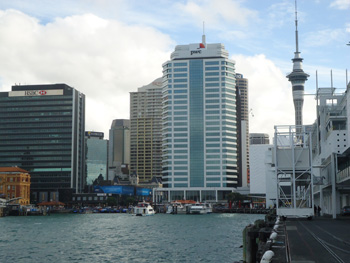 Unfortunately the tide was out this morning as we left Napier and distant waders were too far away to ID as we briefly visited Ahuriri, Meeanee Quay, West Shore Wildlife Reserve along Watchman Road, picking up al the usual species on the way. After a lunch-time snack overlooking Lake Taupo, enjoying the sunshine, with both Black-billed and Red-billed Gull in close attendance we continued to Auckland, arriving in the late afternoon.
Unfortunately the tide was out this morning as we left Napier and distant waders were too far away to ID as we briefly visited Ahuriri, Meeanee Quay, West Shore Wildlife Reserve along Watchman Road, picking up al the usual species on the way. After a lunch-time snack overlooking Lake Taupo, enjoying the sunshine, with both Black-billed and Red-billed Gull in close attendance we continued to Auckland, arriving in the late afternoon.
8th January – Miranda Seabird Centre then Sandspit & Warkworth
We turned up at the quayside for our ferry to Tititiri Matangi, booked months ago, to be told it had been cancelled due to bad weather in the gulf. Despite having both our email address and phone number we had not been advised. The light drizzle soon changed to heavy rain and the wind picked up; not ideal bird watching conditions. Rather than just heading north to our next destination we decided to visit Miranda, where hopefully the rain would have eased and in any event we could enjoy some birds from the car. Fat chance; if anything the rain increased in intensity and with very brisk onshore winds we got drowned every time we opened the windows. We did manage to find c10 Wrybill, NZ Plover, c5 Double-banded Plover, c30 Bar-tailed Godwit and 4 Sharp-tailed Sandpiper along with all the more common species before heading back north. Perhaps the cancellation of the Tiritiri trip was a blessing in disguise as the rain was so heavy on our way back to Auckland on the motorway that we could barely see the road ahead and only managed to stay in our lane because we were hemmed in by all the other cars – road markings were non-existent. As we travelled north of Auckland the weather slowly cleared up and, being a little early to check-in to our B&B, we drove to Sandspit where we saw a pair of California Quail and a Buff-banded Rail.
9th January – Tawharanui Regional Park & Omaha
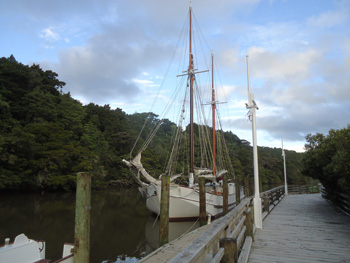 Our original itinerary had included a pelagic trip out of the Huraki Gulf from Sandspit with Pterodroma Pelagics and hence our stay at Warkworth. Whilst we were in Melbourne we received an email to say the trip would not be going ahead as there were no other participants. This trip would have cost us NZ$340 per person. Fortunately, when we booked with Detlef Davies at Birder’s Rest I had advised him we were interested in sea birds and over the following months he arranged to charter a boat to co-incide with our visit. Having contacted several acquaintances in the intervening period, he was able to offer us a pelagic from the Bay of Islands at a fraction of the cost of Pterodroma Pelagics (NZ$80 per person). If you are thinking of arranging a pelagic in this area, look out! There is a serious value for money issue. In the gardens around the B&B we saw 2 Sacred Kingfisher, our first pheasant and 3 California Quail amongst others. We decided to visit Tawharanui Regional Park, one of several peninsula areas in New Zealand now protected by predator proof fences. As we drove to the park one of the nearby bays hosted a single NZ Plover, several Variable Oystercatcher and a pair of Black-billed Gull. Caspian Tern flew over the inlet at the park entrance and as we drove into the park we spotted several Tui, Bellbird and a couple of Kaka.
Our original itinerary had included a pelagic trip out of the Huraki Gulf from Sandspit with Pterodroma Pelagics and hence our stay at Warkworth. Whilst we were in Melbourne we received an email to say the trip would not be going ahead as there were no other participants. This trip would have cost us NZ$340 per person. Fortunately, when we booked with Detlef Davies at Birder’s Rest I had advised him we were interested in sea birds and over the following months he arranged to charter a boat to co-incide with our visit. Having contacted several acquaintances in the intervening period, he was able to offer us a pelagic from the Bay of Islands at a fraction of the cost of Pterodroma Pelagics (NZ$80 per person). If you are thinking of arranging a pelagic in this area, look out! There is a serious value for money issue. In the gardens around the B&B we saw 2 Sacred Kingfisher, our first pheasant and 3 California Quail amongst others. We decided to visit Tawharanui Regional Park, one of several peninsula areas in New Zealand now protected by predator proof fences. As we drove to the park one of the nearby bays hosted a single NZ Plover, several Variable Oystercatcher and a pair of Black-billed Gull. Caspian Tern flew over the inlet at the park entrance and as we drove into the park we spotted several Tui, Bellbird and a couple of Kaka. 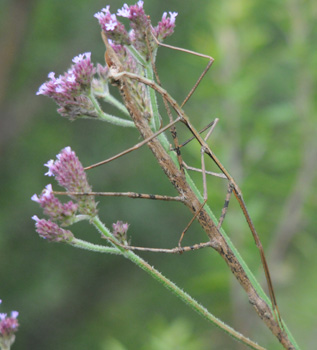 Being Saturday, the beach area was quite crowded, with more cars arriving every minute so we decided to walk around the small wetland area near the park entrance. It was very quiet with few birds about: we did find an interesting Stick Insect, well concealed on a Verbena flower and as we came to the final third of the walk we were astounded to see an Austarlasian Bittern take flight from one of the few bits of open water and disappear in to the nearby bushes. Prior to this we had only managed Sacred Kingfisher, NZ Fantail and a couple of unidentified parrots flying overhead. Finally we encountered 3 of the resident SI Takahe as we came to the end of the trail. Back to the car park near the entrance and the small lagoon by the inlet and much to our surprise we found 7 Brown Teal amongst the Grey Duck and Paradise Shelduck. I swear they weren’t there the first time we stopped and looked! We moved on to Omaha and, once again, we caught the tide at the wrong time. In addition to both Oystercatchers and White-headed Stilt, we saw c10 Bar-tailed Godwit and a single NZ Dotterel on the mud banks exposed at low tide. After dark, back at the B&B we heard Morepork once again in the distance.
Being Saturday, the beach area was quite crowded, with more cars arriving every minute so we decided to walk around the small wetland area near the park entrance. It was very quiet with few birds about: we did find an interesting Stick Insect, well concealed on a Verbena flower and as we came to the final third of the walk we were astounded to see an Austarlasian Bittern take flight from one of the few bits of open water and disappear in to the nearby bushes. Prior to this we had only managed Sacred Kingfisher, NZ Fantail and a couple of unidentified parrots flying overhead. Finally we encountered 3 of the resident SI Takahe as we came to the end of the trail. Back to the car park near the entrance and the small lagoon by the inlet and much to our surprise we found 7 Brown Teal amongst the Grey Duck and Paradise Shelduck. I swear they weren’t there the first time we stopped and looked! We moved on to Omaha and, once again, we caught the tide at the wrong time. In addition to both Oystercatchers and White-headed Stilt, we saw c10 Bar-tailed Godwit and a single NZ Dotterel on the mud banks exposed at low tide. After dark, back at the B&B we heard Morepork once again in the distance.
10th January – To Kerikeri via Waipu, Waro Lake & Teal Bay
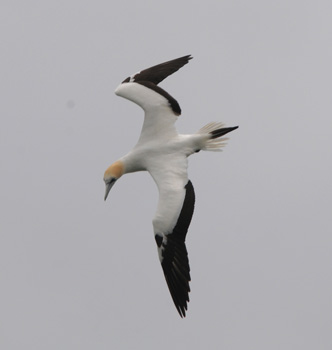 Heading north again today we called in at Waipu, following instructions we had received from Detlef covering most of the sites mentioned in this section. The tide was just going out, so the waders were quite close - 3 Turnstone, c40 NZ Dotterel, 8 Sharp-tailed Sandpiper, 4 White-headed Stilt, c8 Double-banded Plover, 2 Caspian Tern, Variable Oystercatcher and hundreds of Bar-tailed Godwit were feeding eagerly in front of us whilst Welcome Swallow skimmed the pools left by the retreating tide. We could see the tern colony on the sand bank at the mouth of the tidal creeks and walked around the beach and along the man-made breakwater to get a little closer. Three Australasian Gannet flew alongside us diving in the creek from time to time, almost at our feet. The majority of the birds in the colony were White-fronted Tern, but we were very lucky to spot a Fairy Tern land on a nearby sandbank next to a White-fronted Tern making the size difference immediately obvious. We were able to scope the bird and observe it for a few minutes before surfers returning from the open water waded across to the beach and disturbed all the birds: we had a further good look at the tern as it flew overhead and out to sea.
Heading north again today we called in at Waipu, following instructions we had received from Detlef covering most of the sites mentioned in this section. The tide was just going out, so the waders were quite close - 3 Turnstone, c40 NZ Dotterel, 8 Sharp-tailed Sandpiper, 4 White-headed Stilt, c8 Double-banded Plover, 2 Caspian Tern, Variable Oystercatcher and hundreds of Bar-tailed Godwit were feeding eagerly in front of us whilst Welcome Swallow skimmed the pools left by the retreating tide. We could see the tern colony on the sand bank at the mouth of the tidal creeks and walked around the beach and along the man-made breakwater to get a little closer. Three Australasian Gannet flew alongside us diving in the creek from time to time, almost at our feet. The majority of the birds in the colony were White-fronted Tern, but we were very lucky to spot a Fairy Tern land on a nearby sandbank next to a White-fronted Tern making the size difference immediately obvious. We were able to scope the bird and observe it for a few minutes before surfers returning from the open water waded across to the beach and disturbed all the birds: we had a further good look at the tern as it flew overhead and out to sea.
Moving on we called at Waro Lake, where we picked up NZ Grebe and Australasian Grebe and then Teal Bay, where we saw c25 Brown Teal to the accompaniment of the song of Skylark and Yellowhammer. 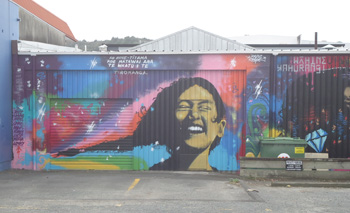 As we arrived at Birder’s Rest, Kerikeri we were greeted by several California Quail running across the driveway and even before we had chance to unpack our cases Detlef and Carol took us to see a pair of Morepork and their 3 fluffy juveniles in their garden, where we also heard a Shining Bronze Cuckoo and saw pairs of Eastern Rosella and Ringed Turtle Dove. A little after 20.30 we went out with Carol to look for Kiwi: we saw 8 Wild Turkey on the way but spent a little over 2 hours wandering along hilly tracks, hearing, but not seeing any birds. Eventually, as we were on our way back to the car, Carol heard a noise from a gully at the side of the track and eventually I managed to catch a brief glimpse of young North Island Brown Kiwi as it broke from cover and shot off in to the undergrowth. By this time Amanda had already had enough, and with a steep climb ahead, was on her way to the car park. We did see a Brushtailed Possum in the road on our way back to Kerikeri, where we arrived just before midnight. Bit of a bummer really as we were due out at 06.30 the following morning for the pelagic.
As we arrived at Birder’s Rest, Kerikeri we were greeted by several California Quail running across the driveway and even before we had chance to unpack our cases Detlef and Carol took us to see a pair of Morepork and their 3 fluffy juveniles in their garden, where we also heard a Shining Bronze Cuckoo and saw pairs of Eastern Rosella and Ringed Turtle Dove. A little after 20.30 we went out with Carol to look for Kiwi: we saw 8 Wild Turkey on the way but spent a little over 2 hours wandering along hilly tracks, hearing, but not seeing any birds. Eventually, as we were on our way back to the car, Carol heard a noise from a gully at the side of the track and eventually I managed to catch a brief glimpse of young North Island Brown Kiwi as it broke from cover and shot off in to the undergrowth. By this time Amanda had already had enough, and with a steep climb ahead, was on her way to the car park. We did see a Brushtailed Possum in the road on our way back to Kerikeri, where we arrived just before midnight. Bit of a bummer really as we were due out at 06.30 the following morning for the pelagic.
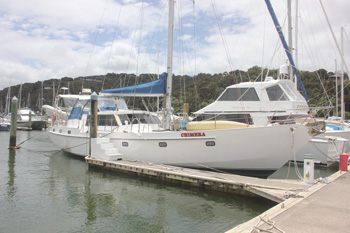 11th January – Bay of Islands Pelagic & return south to Whangaparaoa
11th January – Bay of Islands Pelagic & return south to Whangaparaoa
The boat was a comfortable Yacht, Chimera, with a crew of three including the skipper and we set sail at 07.00. Once out in open water the sea had quite a swell and we eventually ended up between 20 & 25 miles from the Kerikeri Marina. Unfortunately several of the other passengers seemed to be almost as keen to go fishing as birding and consequently we were delayed at least half a dozen times as first one, then another caught and landed small Tuna. Still, by and large they were a companionable bunch with reasonable bird ID skills, certainly much better than us two novices. Before we left the protection of the islands we encountered Caspian Tern, c3 Arctic Skua, Australasian Gannet, Little Penguin and Pacific Reef Heron. As we approached open water we saw the first of many Buller’s Shearwater, c40 White-faced Storm Petrel, 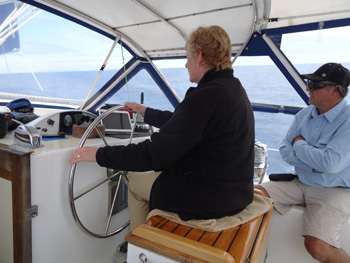 c15 Fluttering Shearwater, c5 Flesh-footed Shearwater, c6 Black-winged Petrel, c6 Cook’s Petrel, a single Pycroft’s Petrel (identified from photos when we were back on shore), c5 Black Petrel, a single Little Shearwater & Fairy Prion and at least 2 New Zealand Storm Petrel which appeared at the farthest point of our cruise when fish oil and assorted chum was spread on the water behind the boat. This also brought the largest concentration of White-faced Storm Petrel and as we started back to shore we were followed quite some distance by several White-faced and possibly a third NZ Storm Petrel. Apart from the Tuna, we also saw 3 Pacific Bottlenose Dolphin and a lone Flying Fish. Amanda was offered the wheel as soon as we turned back to shore and, delighted, she steered us for the next c15 miles until we neared land again.
c15 Fluttering Shearwater, c5 Flesh-footed Shearwater, c6 Black-winged Petrel, c6 Cook’s Petrel, a single Pycroft’s Petrel (identified from photos when we were back on shore), c5 Black Petrel, a single Little Shearwater & Fairy Prion and at least 2 New Zealand Storm Petrel which appeared at the farthest point of our cruise when fish oil and assorted chum was spread on the water behind the boat. This also brought the largest concentration of White-faced Storm Petrel and as we started back to shore we were followed quite some distance by several White-faced and possibly a third NZ Storm Petrel. Apart from the Tuna, we also saw 3 Pacific Bottlenose Dolphin and a lone Flying Fish. Amanda was offered the wheel as soon as we turned back to shore and, delighted, she steered us for the next c15 miles until we neared land again.
We arrived back at the Marina around 17.30 and immediately set off south again to Whangaparaoa; 8 Wild Turkey were the only species of note seen on the way.
12th January – Gulf Harbour, Waiwera Strakas Lakes & Shakespear Regional Park
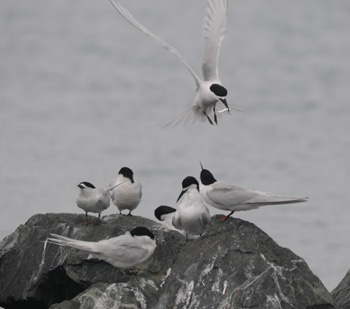 Rain had set in overnight and continued on and off most of the day. We had a gentle day around the peninsula, visiting Gulf Harbour where c170 White-fronted Tern roosted on the breakwater. There was nothing particularly unusual at Waiwera where we saw Grey Teal & NZ Scaup on the lakes, 2 NZ Plover nearby and c50 Fluttering Shearwater flying across one of the many bays. We eventually moved on to Shakespear RP mid afternoon and, still in the rain, managed to find 2 Tui, c5 California Quail, Buff-banded Rail, 2 Sacred Kingfisher and c4 Eastern Rosella. We returned to our apartment via Gulf Harbour where we added c20 Canada Goose.
Rain had set in overnight and continued on and off most of the day. We had a gentle day around the peninsula, visiting Gulf Harbour where c170 White-fronted Tern roosted on the breakwater. There was nothing particularly unusual at Waiwera where we saw Grey Teal & NZ Scaup on the lakes, 2 NZ Plover nearby and c50 Fluttering Shearwater flying across one of the many bays. We eventually moved on to Shakespear RP mid afternoon and, still in the rain, managed to find 2 Tui, c5 California Quail, Buff-banded Rail, 2 Sacred Kingfisher and c4 Eastern Rosella. We returned to our apartment via Gulf Harbour where we added c20 Canada Goose.
13th January – TiriTiri Matangi from Gulf Harbour
We caught the Auckland ferry at 09.50 heading across the edge of the Hauraki Gulf to Tiritiri Matangi under a cloudless sky. What a difference a day makes! On the crossing we saw c20 Fluttering Shearwater, Caspian Tern and White-fronted Tern and both usual gulls. The island itself is a haven for native NZ landbirds and on a beautiful sunny day we managed to find c3 Stitchbird, NI Robin, Whitehead, 2 Saddleback, Red-fronted Parakeet, Sacred Kingfisher, NZ Fantail and, finally, our main target 3 Kokako, our final lifer in New Zealand.
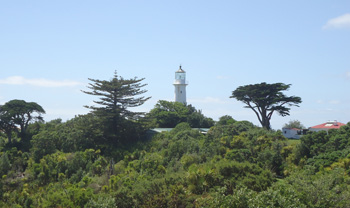 14th January – Return to Auckland via Long Bay, Browns Bay & Devonport
14th January – Return to Auckland via Long Bay, Browns Bay & Devonport
Despite a circuitous route and a number of different habitats we only managed to find a few of the more common species today before we flew to Sydney at 16.05. The only sighting of note was a Brown Rat at Long Bay National Park. Arrival in Sydney was fortuitous. Storms had been a feature of the local weather all day and we were one of only two flights landing there in the late afternoon after flying in a holding pattern for the best part of an hour. All other flights had been diverted to Brisbane.
AUSTRALIA
15th January – From Sydney to Kiama, then Budderoo NP, Shellharbour & Bass Point
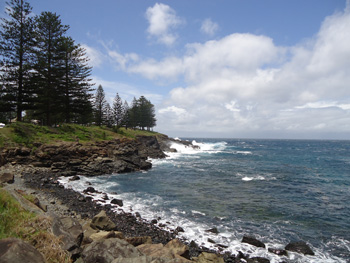 On the drive south we saw several more common Australian species including Sulphur-crested Cockatoo and 2 Australian Pelican. In Kiama noteworthy species were 2 King Parrot and Figbird before we met up with Bob Ashford at 16.00; we had travelled south with the prime intent of catching up with Eastern Ground Parrot. Weather had been changeable all day with frequent rain showers and as we went up in to the hills the rain forest lived up to its name. We started at Budderoo NP where Bob had seen our target earlier in the day; infrequent showers still persisted and the heathland was very wet. We saw Superb Fairywren as soon as we got out of the car and Little Wattlebird and New Holland Honeyeater flitted about in the trees overhead, but there was no sign of Ground Parrots. The only new species I encountered was a Leech but I only discovered that when I got back to the hotel! As we passed Barren Grounds on our way back to sea level we spotted 2 Superb Lyrebirds at the side of the road. A whistle-stop tour of nearby lakes saw us end the day at Bass Point after visiting Shellharbour and on the way we came across Crimson Rosella, Little Corella, Red-whiskered Bulbul, Chestnut Teal, Pink-eared Duck, Fairy Martin, Crested Pigeon, Musk Duck, Australasian Grebe and Royal Spoonbill amongst others.
On the drive south we saw several more common Australian species including Sulphur-crested Cockatoo and 2 Australian Pelican. In Kiama noteworthy species were 2 King Parrot and Figbird before we met up with Bob Ashford at 16.00; we had travelled south with the prime intent of catching up with Eastern Ground Parrot. Weather had been changeable all day with frequent rain showers and as we went up in to the hills the rain forest lived up to its name. We started at Budderoo NP where Bob had seen our target earlier in the day; infrequent showers still persisted and the heathland was very wet. We saw Superb Fairywren as soon as we got out of the car and Little Wattlebird and New Holland Honeyeater flitted about in the trees overhead, but there was no sign of Ground Parrots. The only new species I encountered was a Leech but I only discovered that when I got back to the hotel! As we passed Barren Grounds on our way back to sea level we spotted 2 Superb Lyrebirds at the side of the road. A whistle-stop tour of nearby lakes saw us end the day at Bass Point after visiting Shellharbour and on the way we came across Crimson Rosella, Little Corella, Red-whiskered Bulbul, Chestnut Teal, Pink-eared Duck, Fairy Martin, Crested Pigeon, Musk Duck, Australasian Grebe and Royal Spoonbill amongst others.
16th January – Buderoo NP & Barren Grounds then return to Sydney via Sea Cliff Bridge, Royal National Park, Garie Beach & Wattamolla Beach
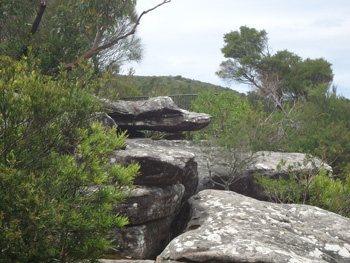 Amanda had had enough of trudging up hill and down dale in the wet yesterday and so I set out alone with Bob at 07.00. Passing Barren Grounds on the way to Budderoo NP again we saw 7 Superb Lyrebird at the roadside and as we parked the car at least 3 Eastern Bristlebird grubbed around on the path in front of us. Although we heard Ground Parrot and Bob thought he saw one, I wasn’t so lucky; I did however manage to see Yellow-tailed Black Cockatoo, Eastern Rosella, Rufous Whistler and White-throated Treecreeper. We moved on to Barren Grounds where the highlight was 4 Beautiful Firetail, closely followed by 3 Red-browed Finch, c8 Eastern Spinebill, 2 Pied Currawong, c3 Eastern Yellow Robin, 2 Grey Shrikethrush, c4 Yellow-faced Honeyeater and another 2 Eastern Bristlebird. As we drove back to Kiama I saw my first Oriental Dollarbird of the trip plus an Australian King Parrot. We were back at the hotel by noon, just in time to check out, have a bite to eat and see 4 Australian Pelican plus an Australian Darter in the bay, so close to the shore they were almost near enough to touch! Taking the scenic route via the Royal National Park we had an enjoyable drive along the coast, but birds were far and few between; the only noteworthy sightings were a single Australasian Gannet, Nankeen Kestrel and Noisy Miner.
Amanda had had enough of trudging up hill and down dale in the wet yesterday and so I set out alone with Bob at 07.00. Passing Barren Grounds on the way to Budderoo NP again we saw 7 Superb Lyrebird at the roadside and as we parked the car at least 3 Eastern Bristlebird grubbed around on the path in front of us. Although we heard Ground Parrot and Bob thought he saw one, I wasn’t so lucky; I did however manage to see Yellow-tailed Black Cockatoo, Eastern Rosella, Rufous Whistler and White-throated Treecreeper. We moved on to Barren Grounds where the highlight was 4 Beautiful Firetail, closely followed by 3 Red-browed Finch, c8 Eastern Spinebill, 2 Pied Currawong, c3 Eastern Yellow Robin, 2 Grey Shrikethrush, c4 Yellow-faced Honeyeater and another 2 Eastern Bristlebird. As we drove back to Kiama I saw my first Oriental Dollarbird of the trip plus an Australian King Parrot. We were back at the hotel by noon, just in time to check out, have a bite to eat and see 4 Australian Pelican plus an Australian Darter in the bay, so close to the shore they were almost near enough to touch! Taking the scenic route via the Royal National Park we had an enjoyable drive along the coast, but birds were far and few between; the only noteworthy sightings were a single Australasian Gannet, Nankeen Kestrel and Noisy Miner.
17th January – Sydney Centennial Park
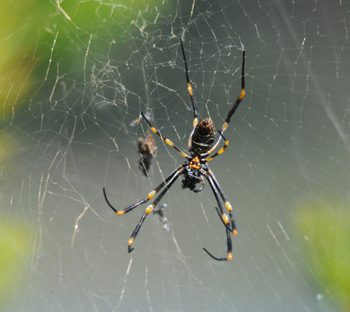 We had arranged to meet local birder, Alan Richards, at noon in the Centennial Park so that he could show us our final lifer of the trip, Powerful Owl. It was a baking hot day and on our way to meet him we spotted a juvenile Fan-tailed Cuckoo, but nothing could compare to the sight of a pair of Powerful Owl roosting under the canopy of a massive old tree – what magnificent birds! Alan then took us on a quick tour of a quieter section of the park and showed us a pair of nesting Tawny Frogmouth underneath a large colony of two species of Flying Foxes. We also picked up Grey Butcherbird, Australasian Figbird, Australasian Darter and a well-concealed Nankeen Night Heron, with a nearby resplendent Golden Orb Spider. Sadly it was time to take our car back to the airport and try and grab a few hours sleep before our early morning flight the following day.
We had arranged to meet local birder, Alan Richards, at noon in the Centennial Park so that he could show us our final lifer of the trip, Powerful Owl. It was a baking hot day and on our way to meet him we spotted a juvenile Fan-tailed Cuckoo, but nothing could compare to the sight of a pair of Powerful Owl roosting under the canopy of a massive old tree – what magnificent birds! Alan then took us on a quick tour of a quieter section of the park and showed us a pair of nesting Tawny Frogmouth underneath a large colony of two species of Flying Foxes. We also picked up Grey Butcherbird, Australasian Figbird, Australasian Darter and a well-concealed Nankeen Night Heron, with a nearby resplendent Golden Orb Spider. Sadly it was time to take our car back to the airport and try and grab a few hours sleep before our early morning flight the following day.
18th January – Fly from Sydney at 06.00 to Dubai and Manchester arriving 18.35. Journey time 25 hours...exhausting!
Back to New Zealand Itinerary & Diary
SUMMARY
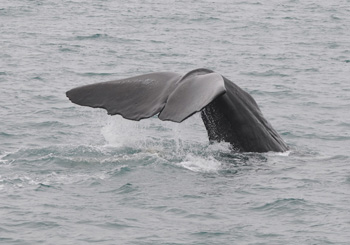 What an amazing way to spend six weeks of the British winter! The scenery in New Zealand is absolutely fantastic, although the number and frequency of UK species encountered can at times become a little boring. Pelagic birding and Whale watching are very rewarding, especially at Kaikoura where the voyage times are quite short as a result of the proximity of the continental shelf just a few miles off-shore.
What an amazing way to spend six weeks of the British winter! The scenery in New Zealand is absolutely fantastic, although the number and frequency of UK species encountered can at times become a little boring. Pelagic birding and Whale watching are very rewarding, especially at Kaikoura where the voyage times are quite short as a result of the proximity of the continental shelf just a few miles off-shore.
Australia is a diverse and exciting place to visit with some wonderful, unusual and sometimes exotic sights and no doubt we will go back again as there are still lots of new areas to explore and birds to see. The three cities we visited are quite different in character and appeal and, unusually for us, we could quite happily have spent more time in each.
We managed to see a total of 64 lifers, about what we expected for second visits to both countries, and heard another three (Western Whipbird, Eastern Ground Parrott and Little Spotted Kiwi).
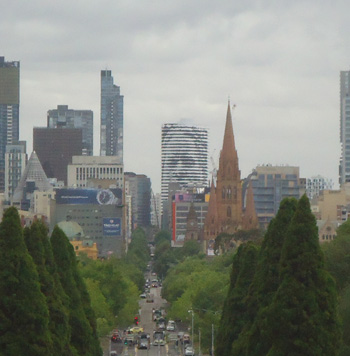 Overall totals were as follows:-
Overall totals were as follows:-
- Western Australia based in Perth and Cheynes Beach – 105 plus 2 heard
- Victoria based in Melbourne – 130 plus 4 heard
- New South Wales based in Sydney & Kiama – 73 plus 2 heard
- Australia – 198 plus 5 heard
- New Zealand – 120 plus 2 heard
- Trip total – 282 plus 6 heard
We didn’t bust a gut chasing new species every day, so we were quite pleased with our results; indeed, in New Zealand we missed out the central highlands and most of the west coast in both North & South Islands as we had been quite successful with the species there on our previous trip.
Trip List - Australia - New Zealand
Bird Photos - Australia - New Zealand
Wildlife Photos
David & Amanda Mason
